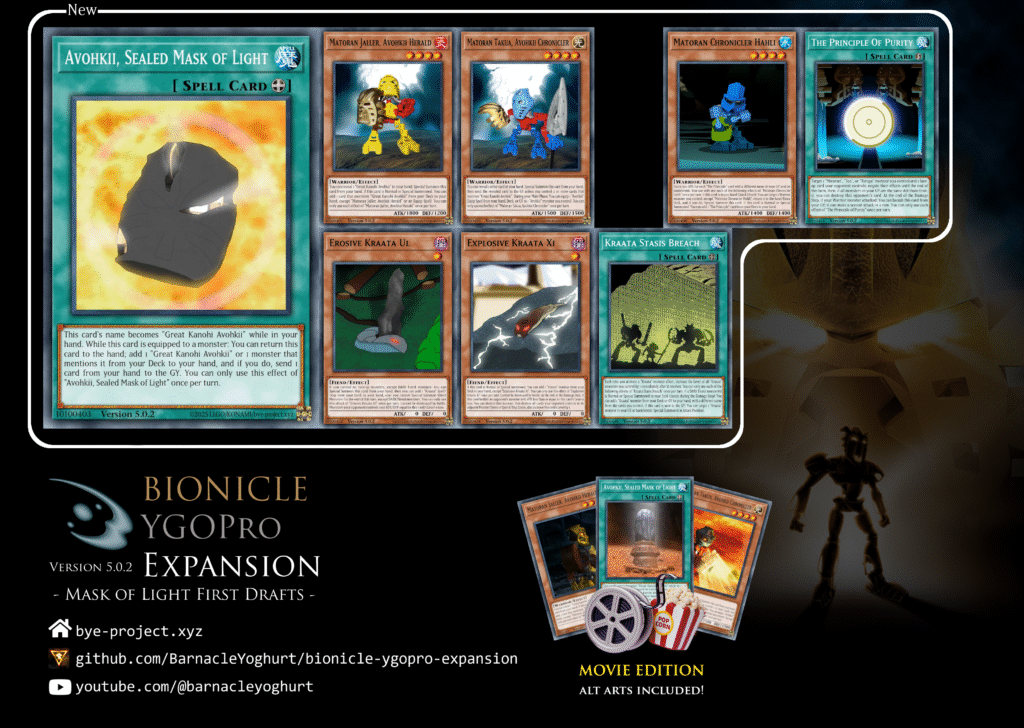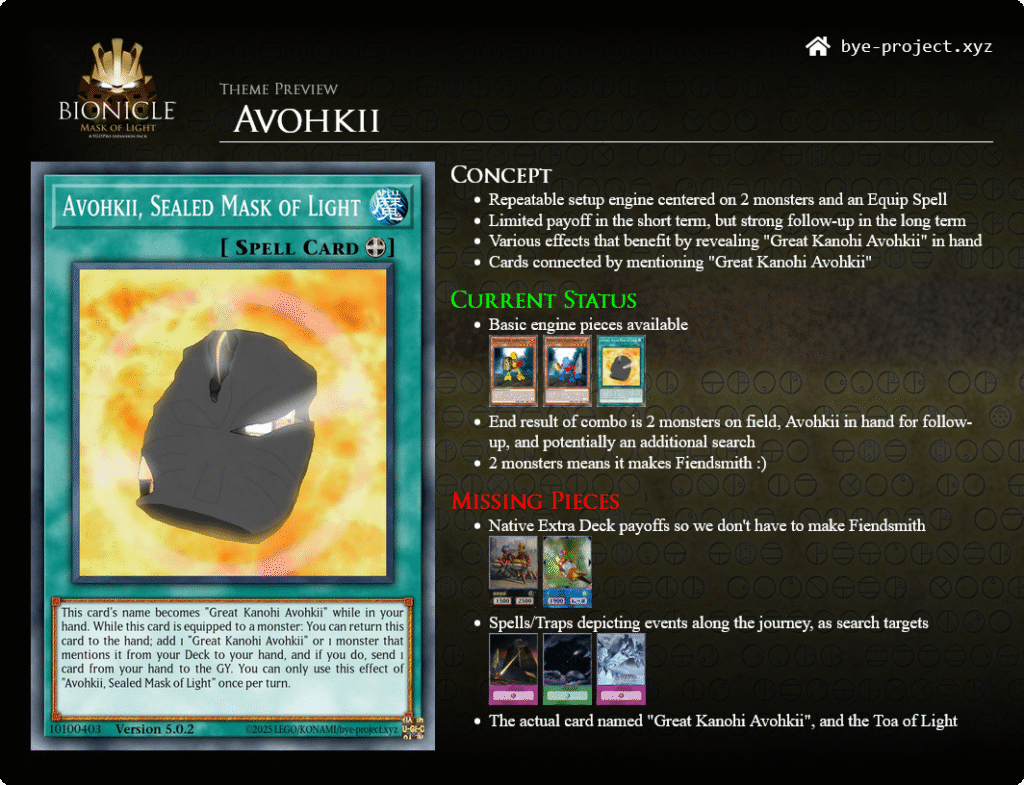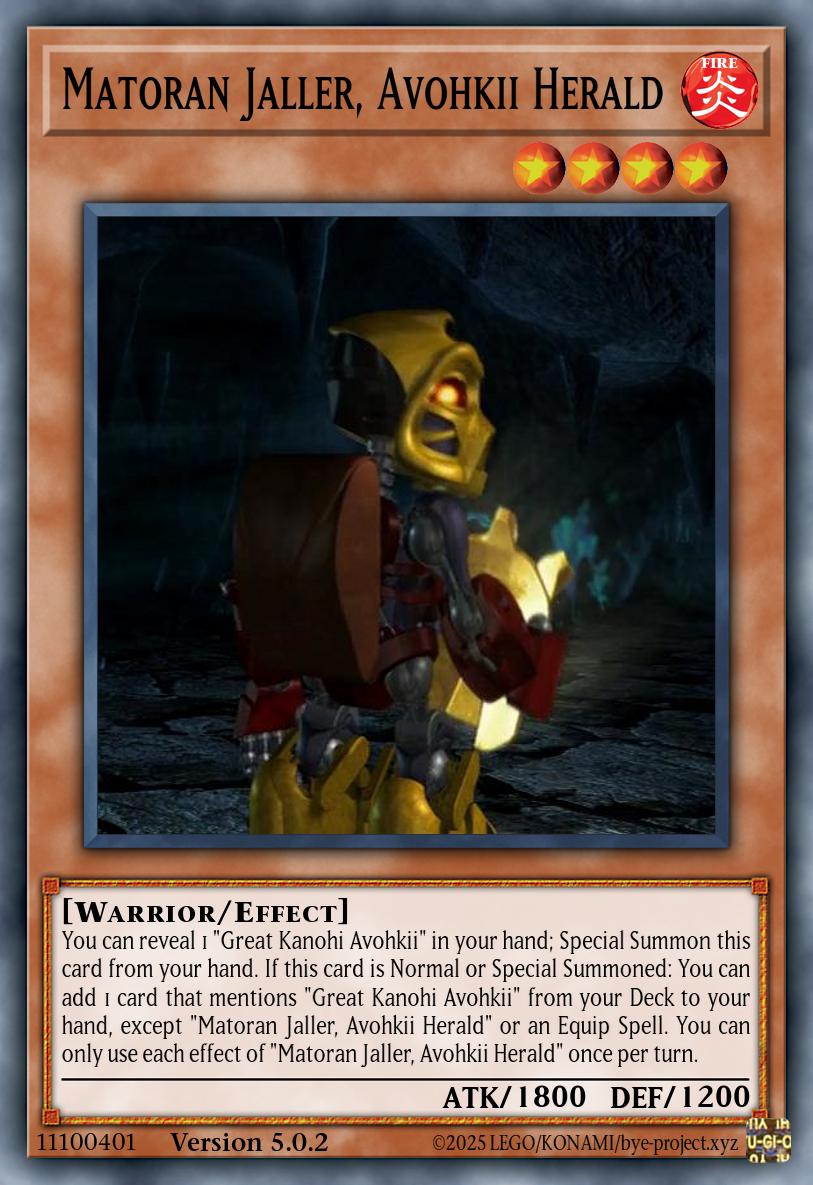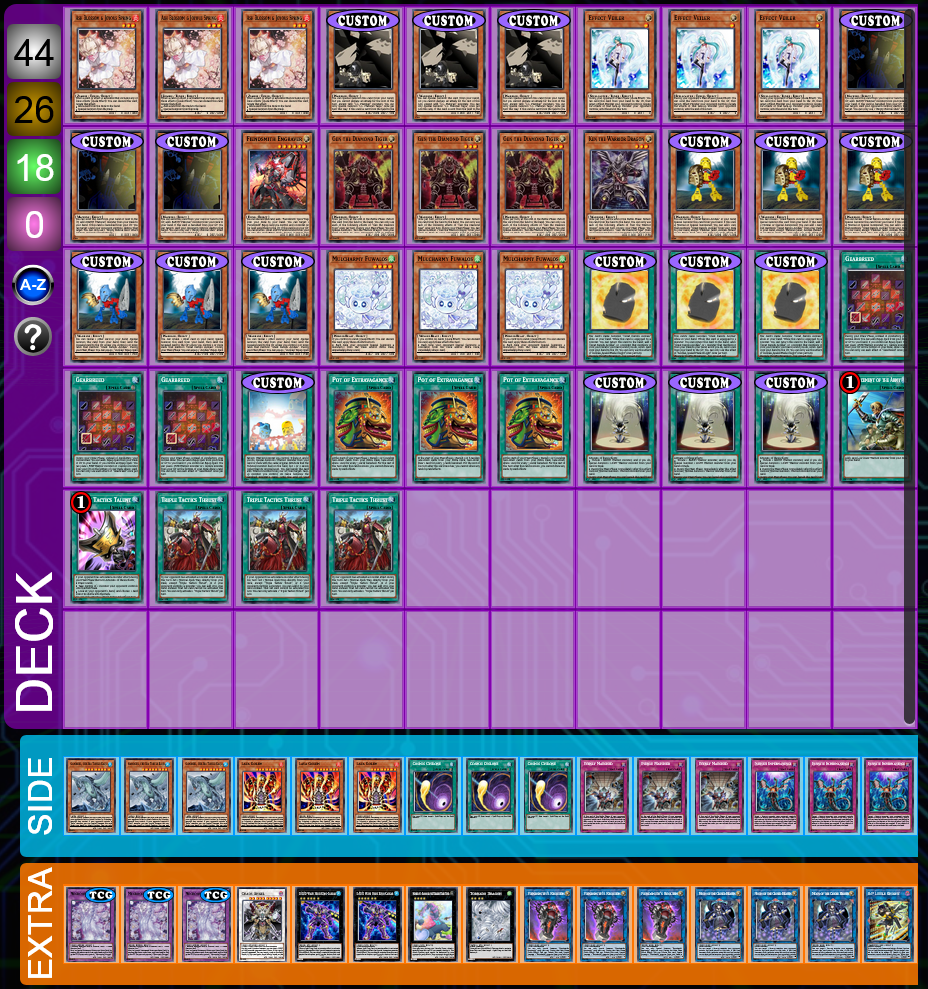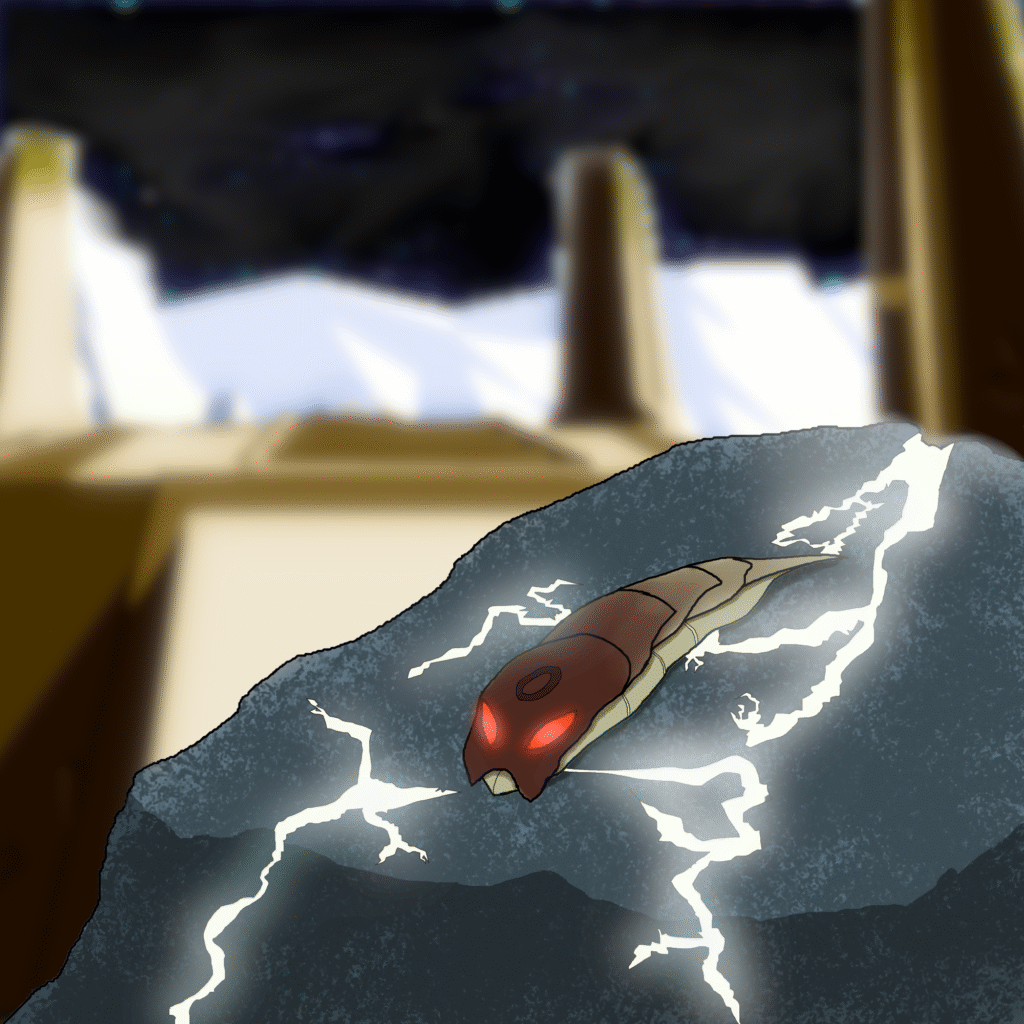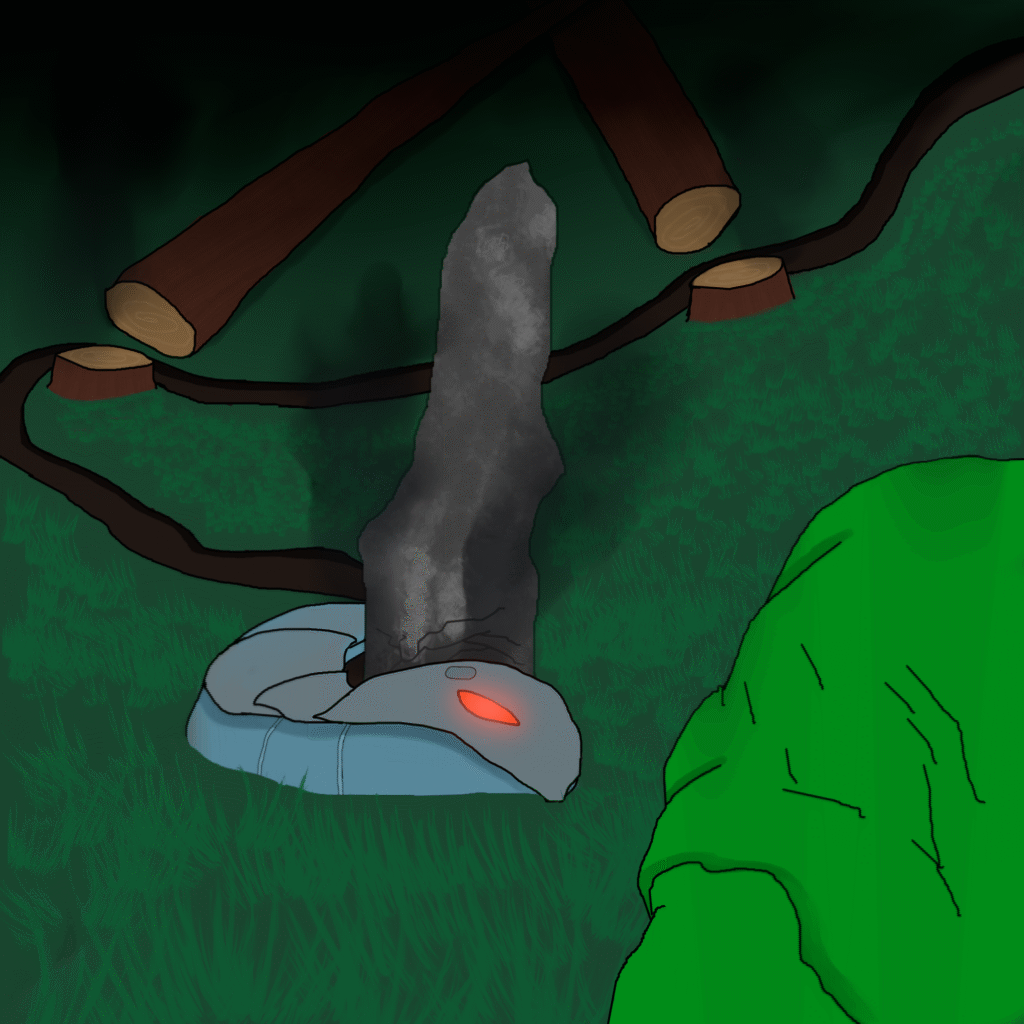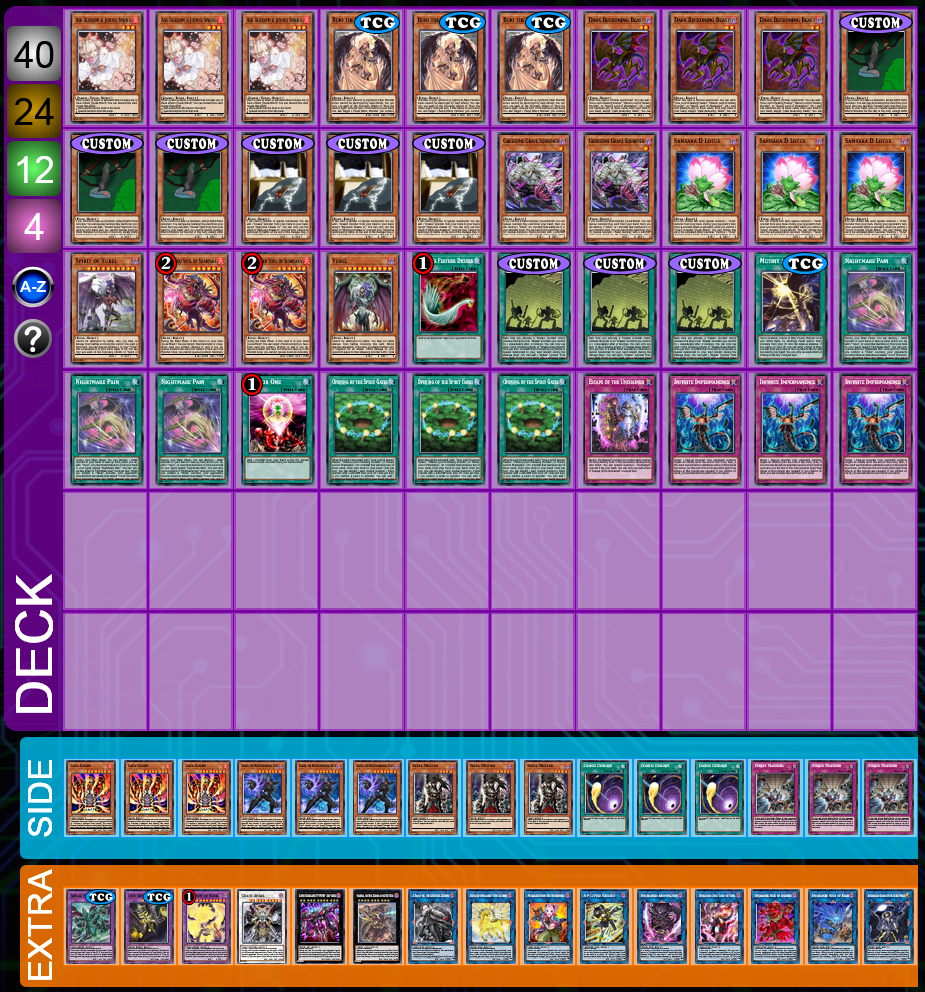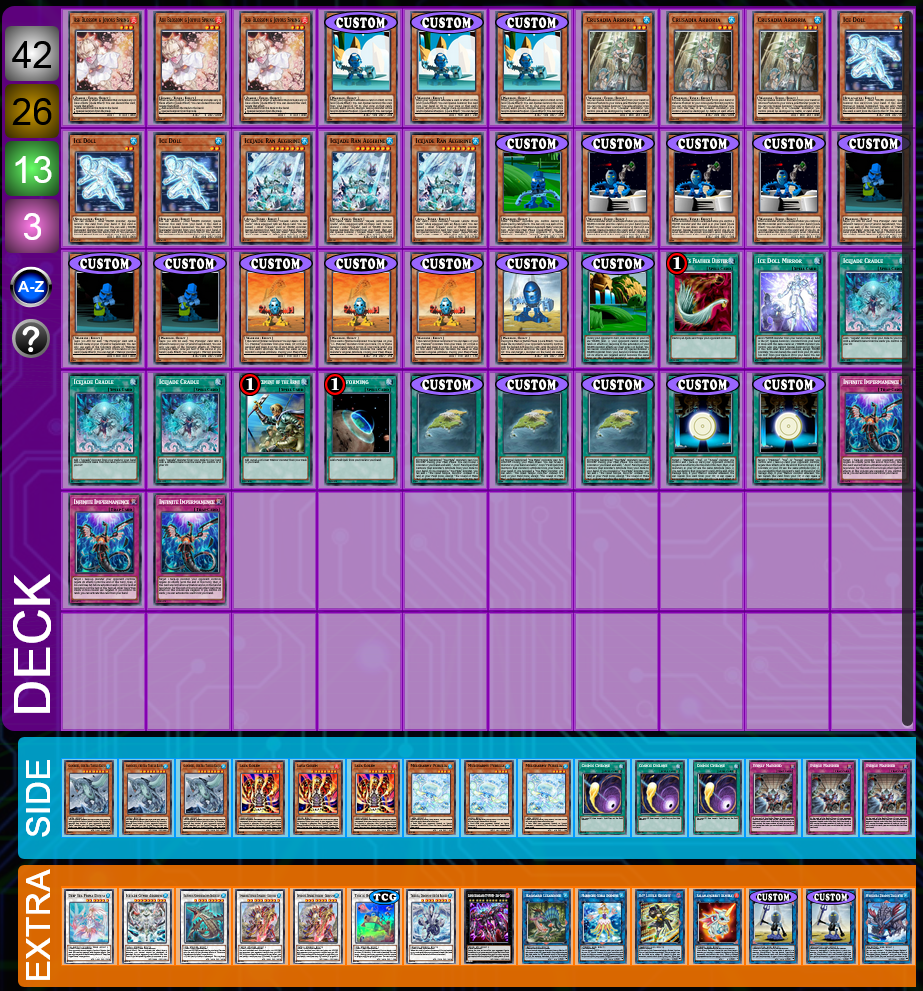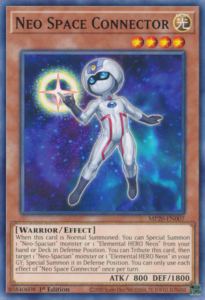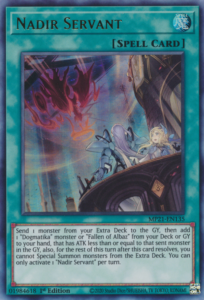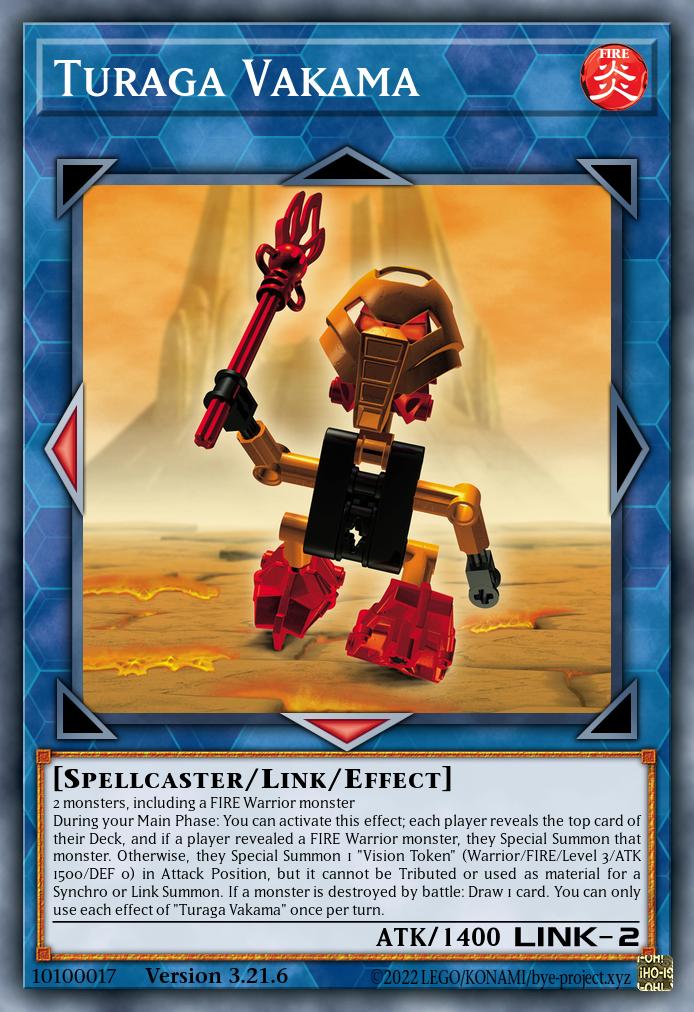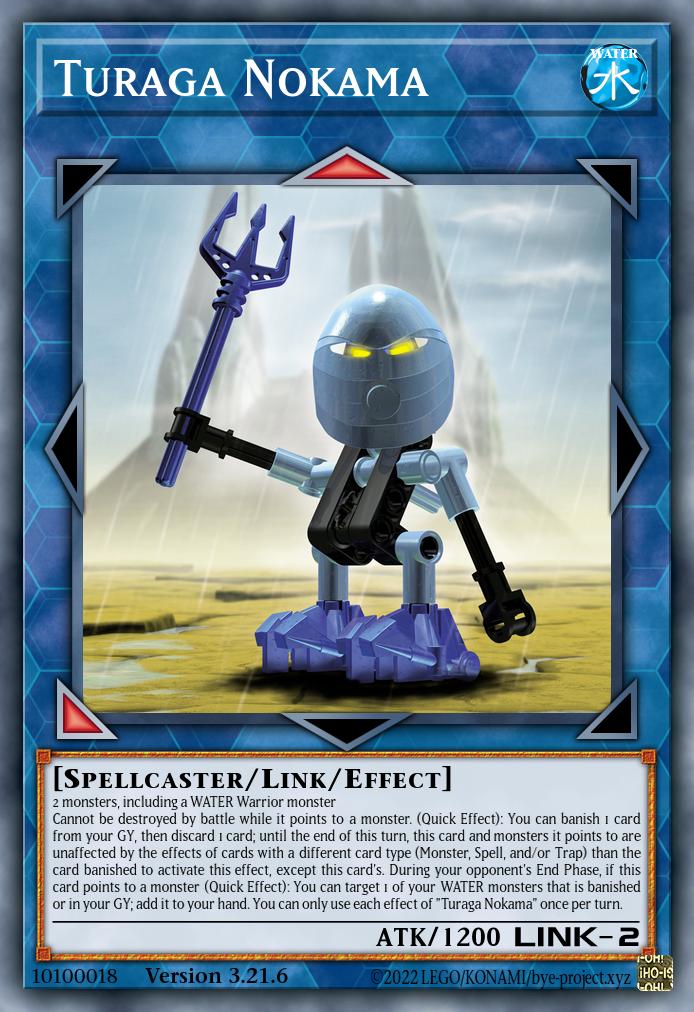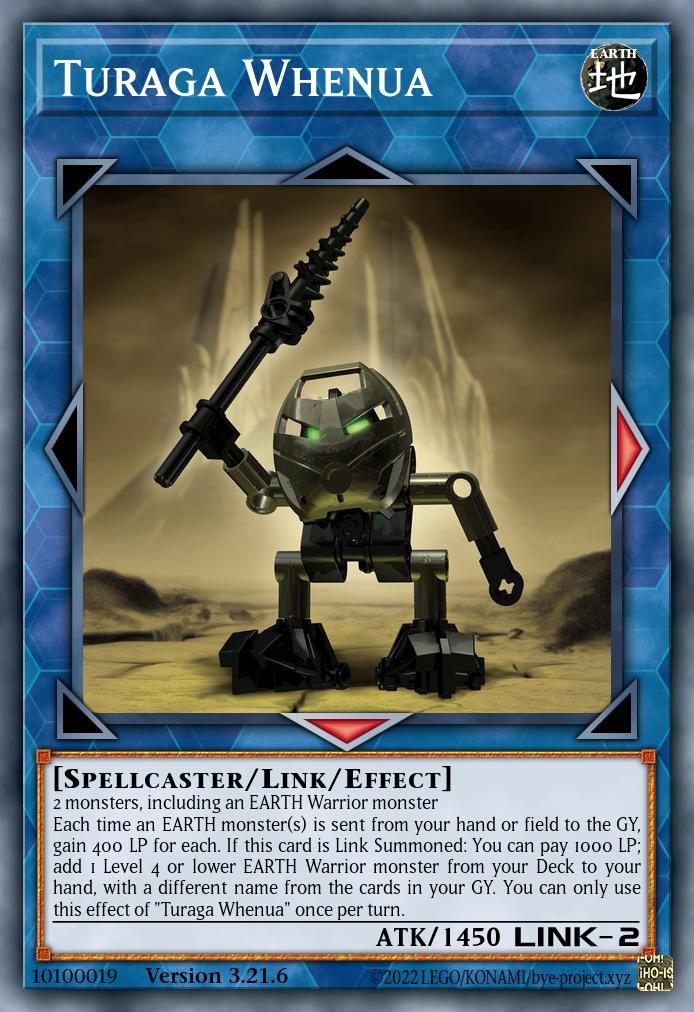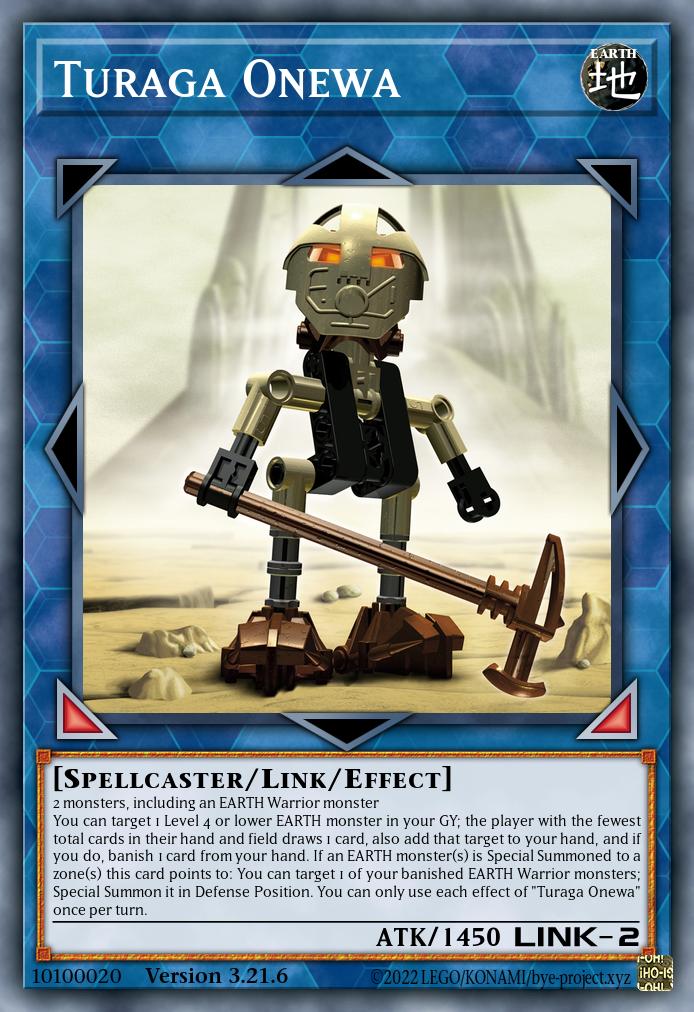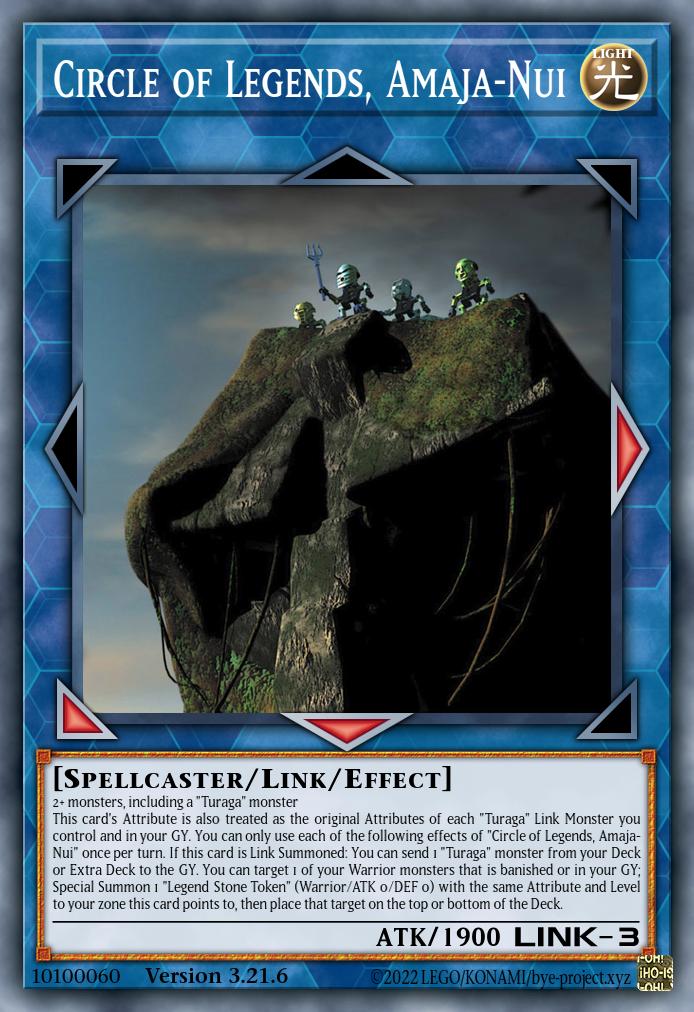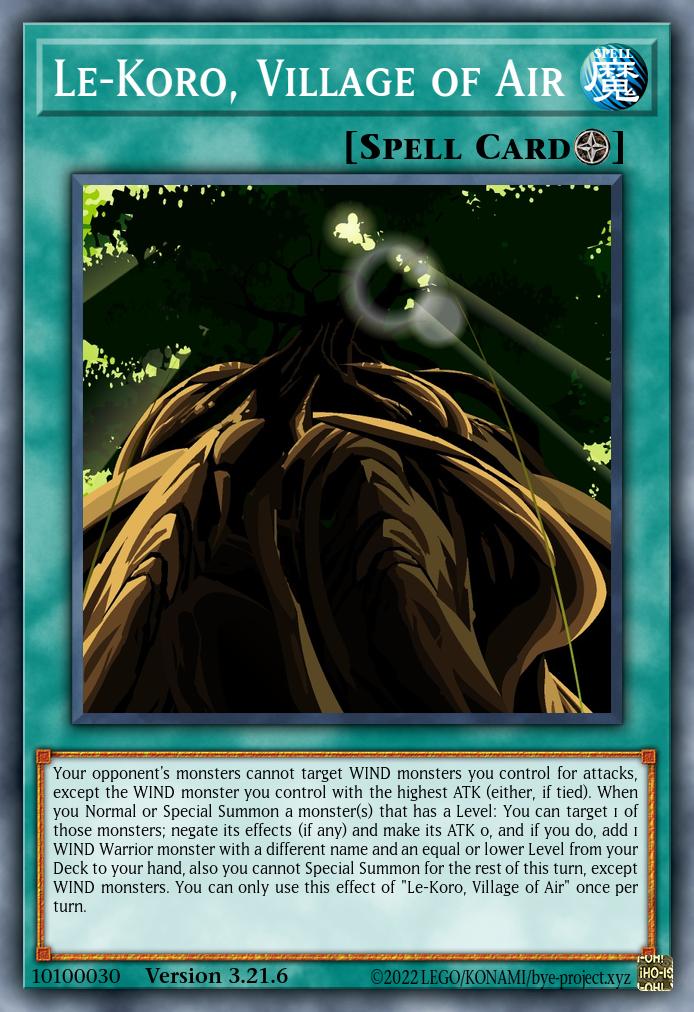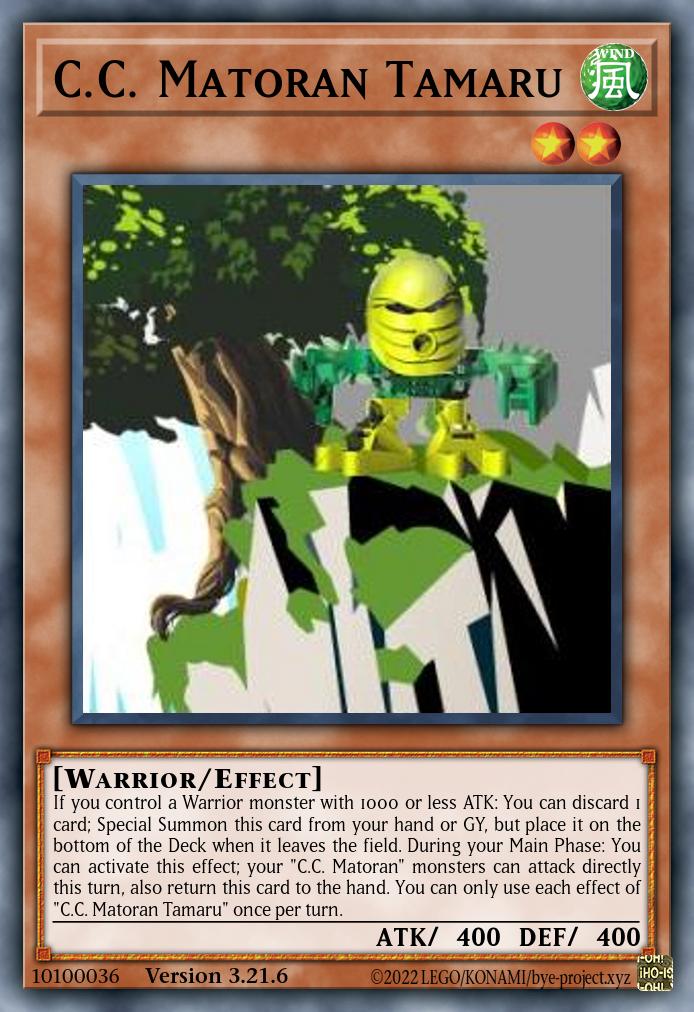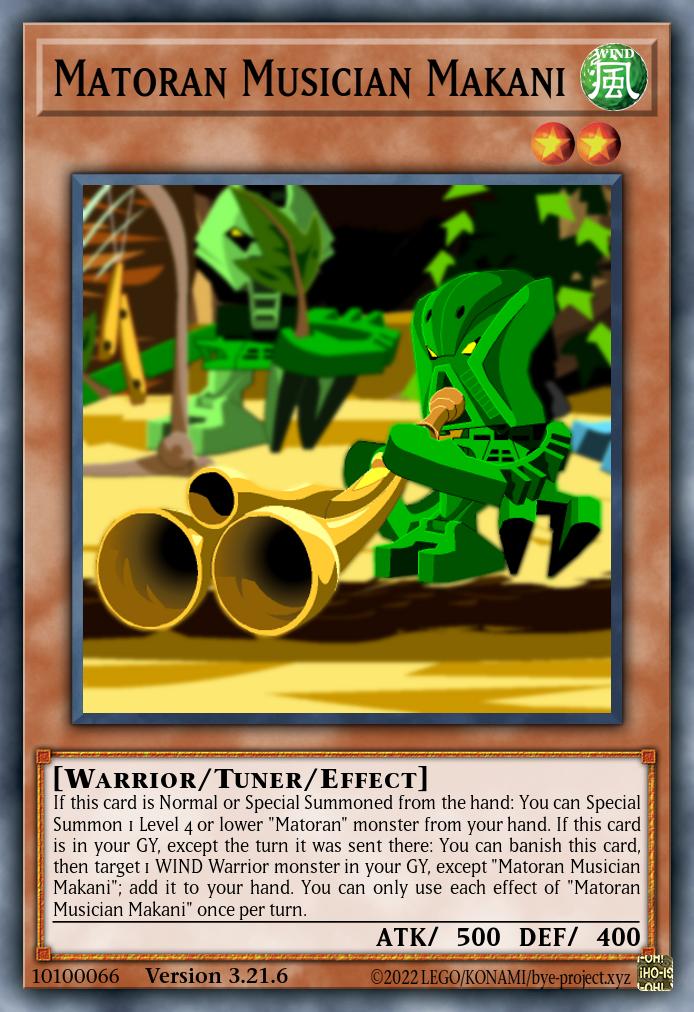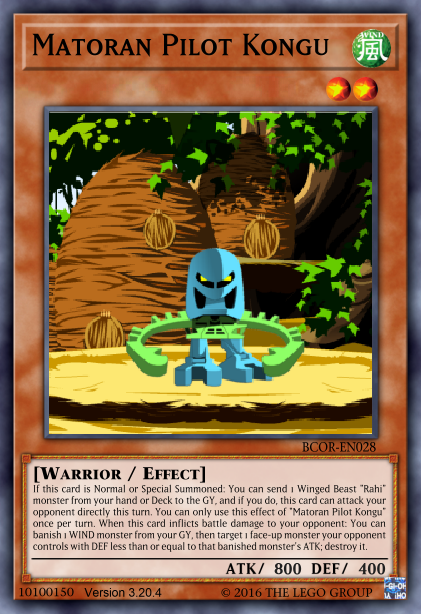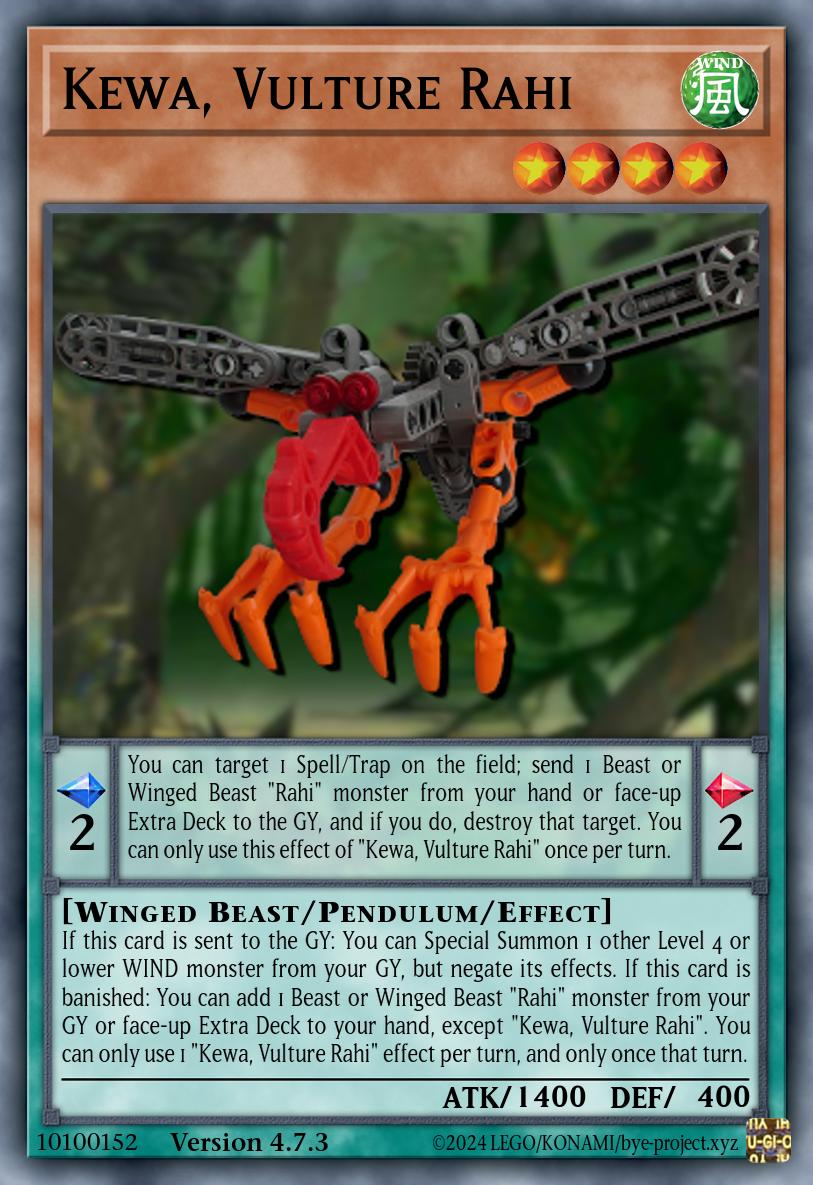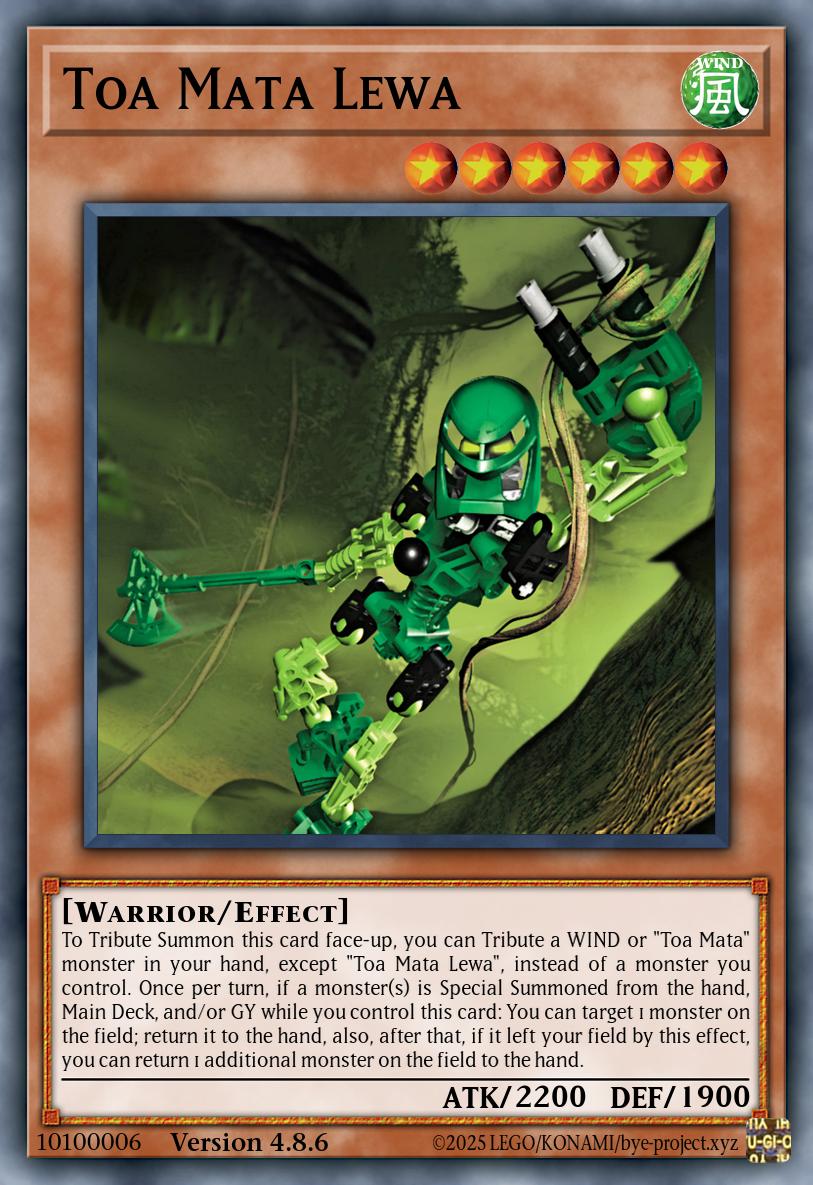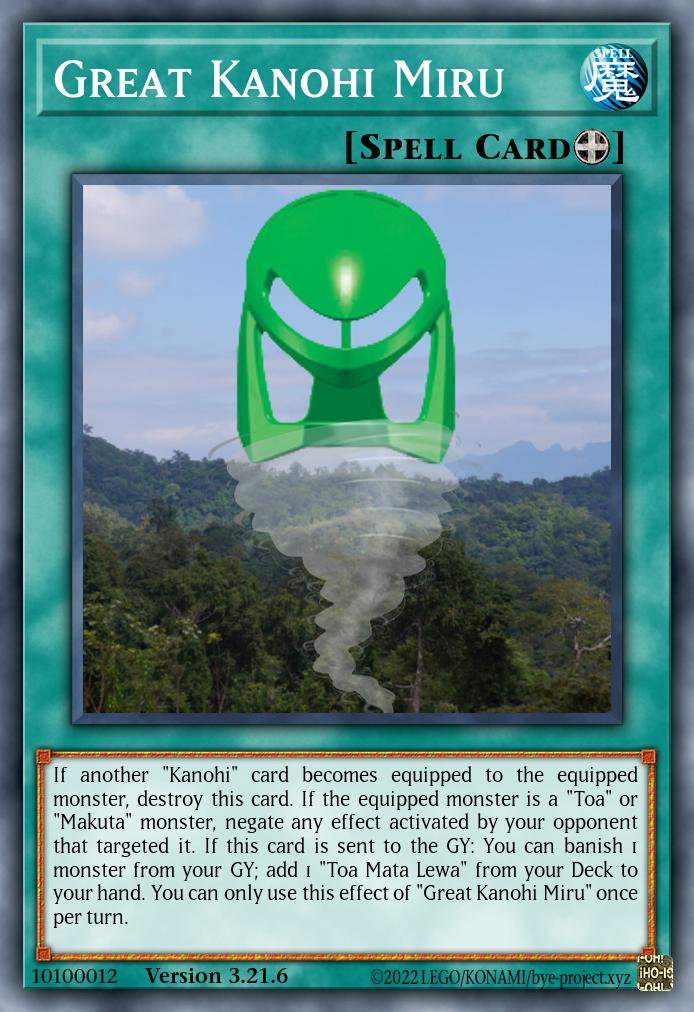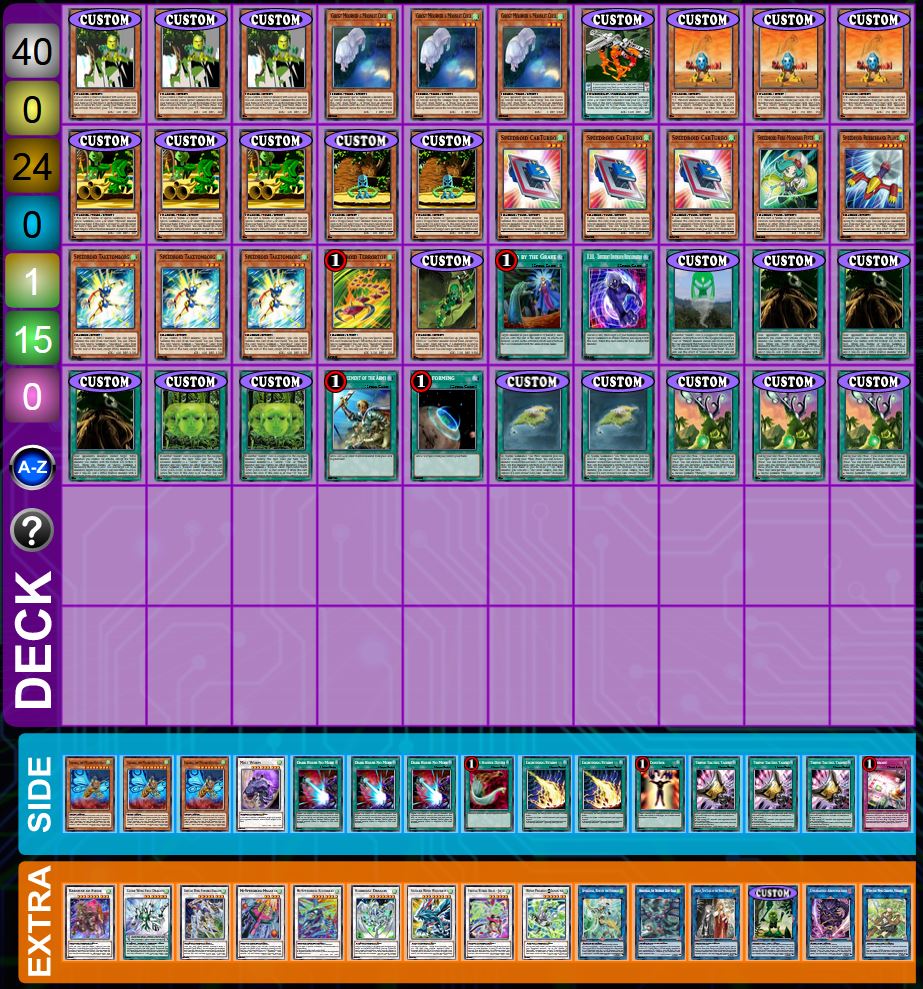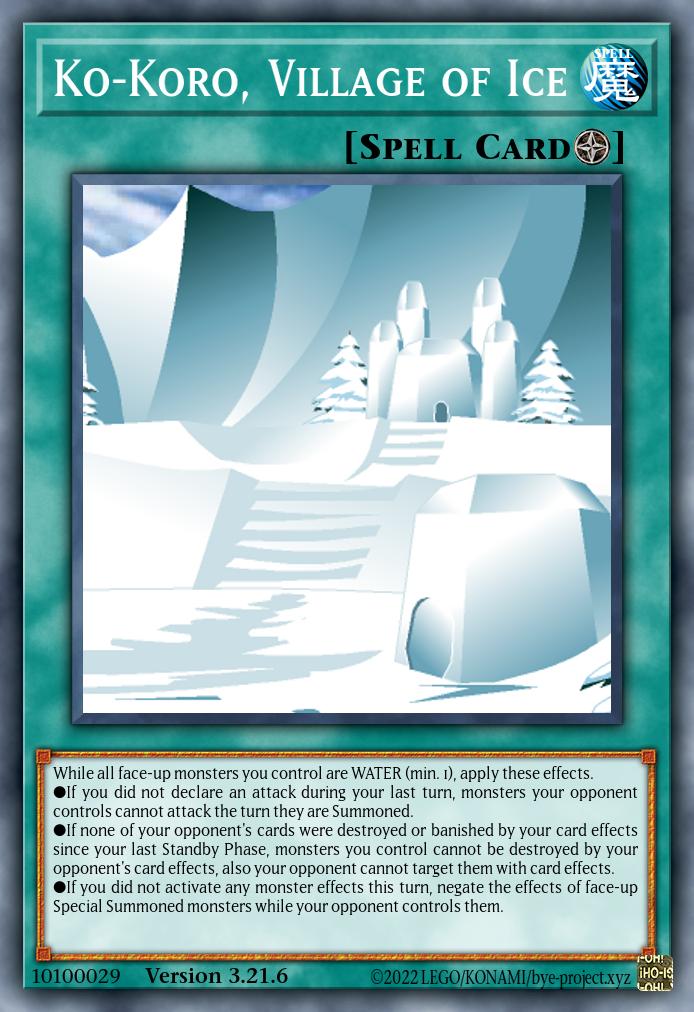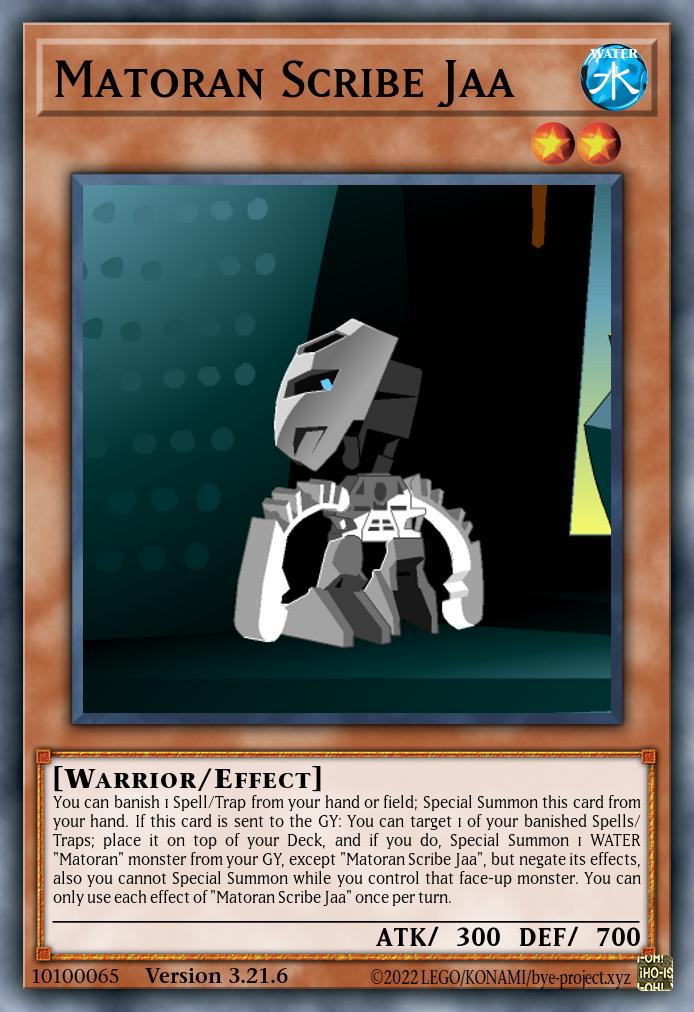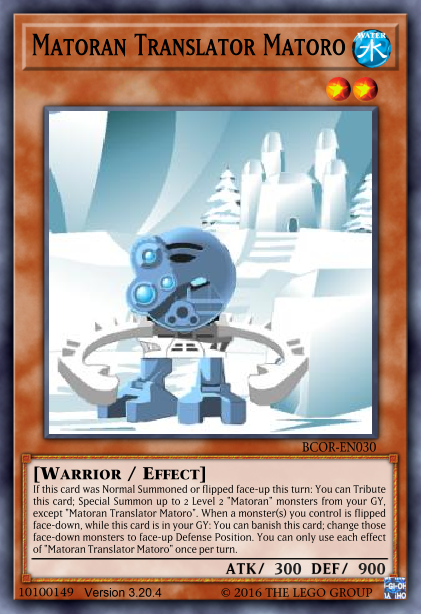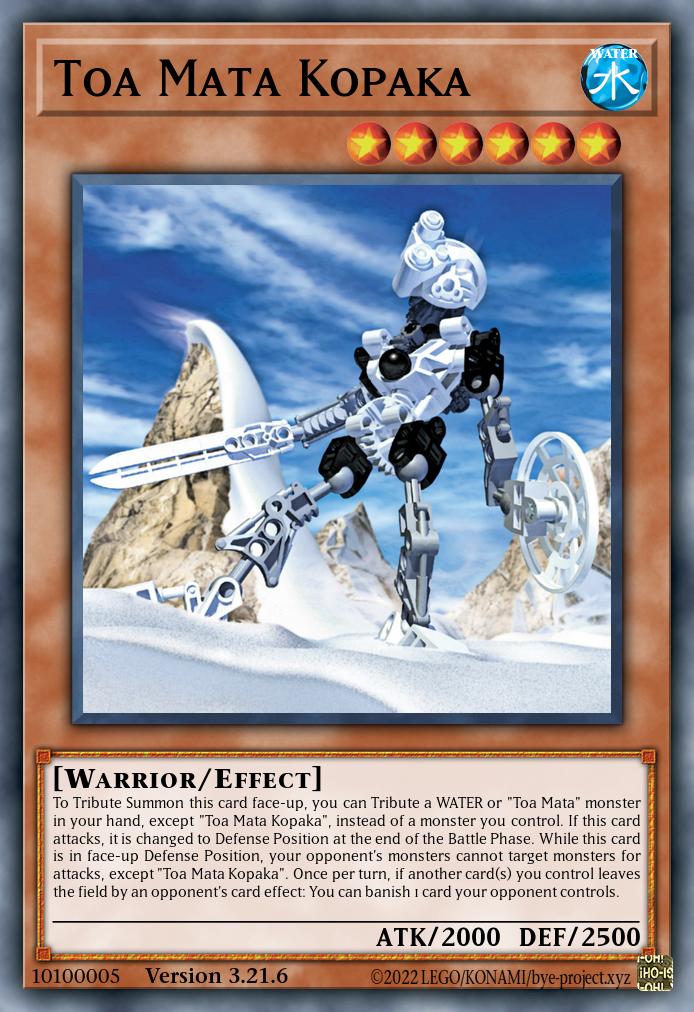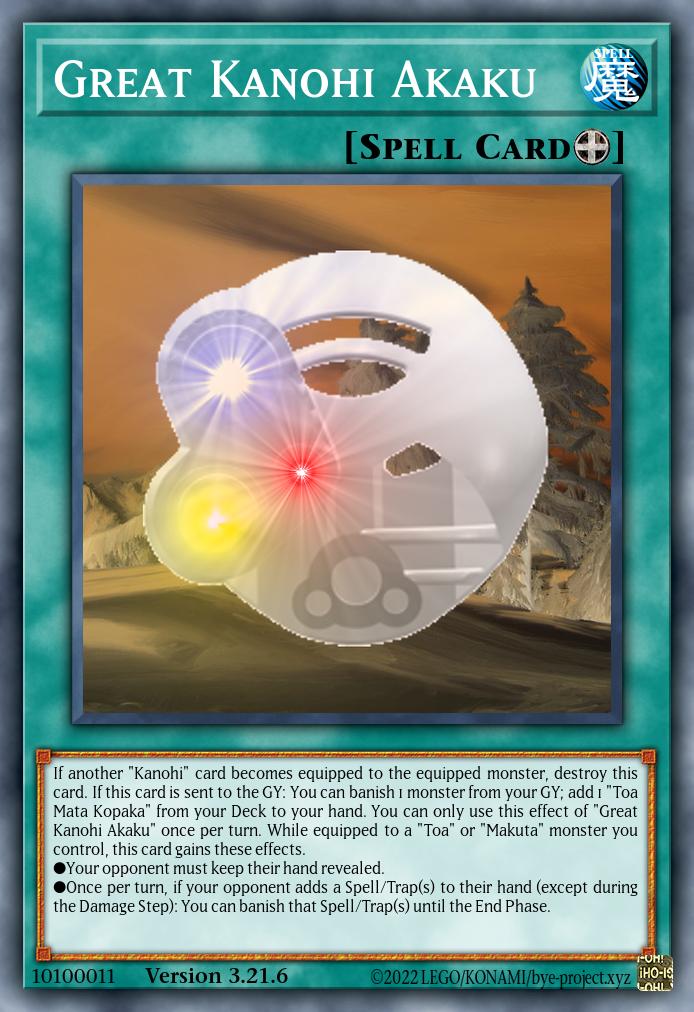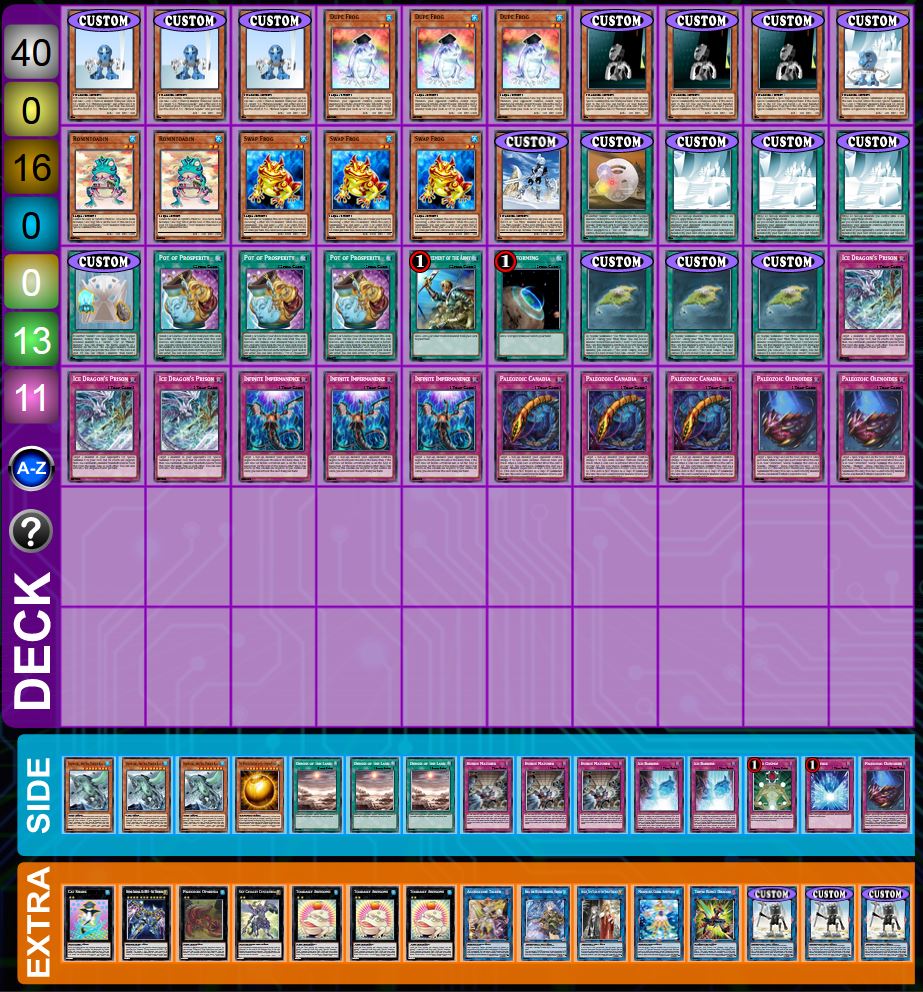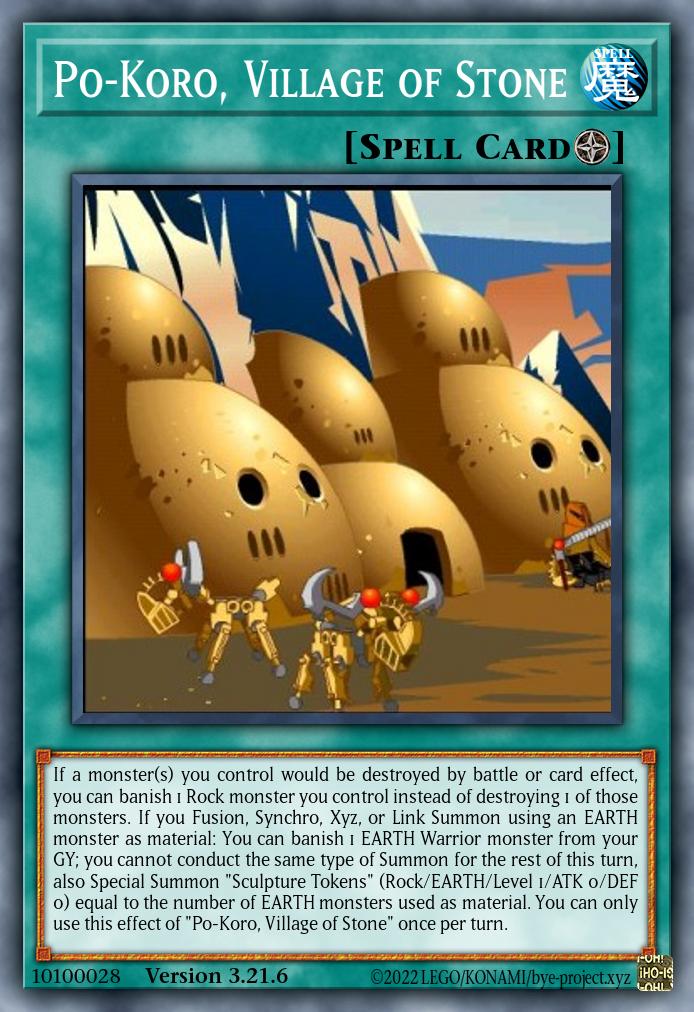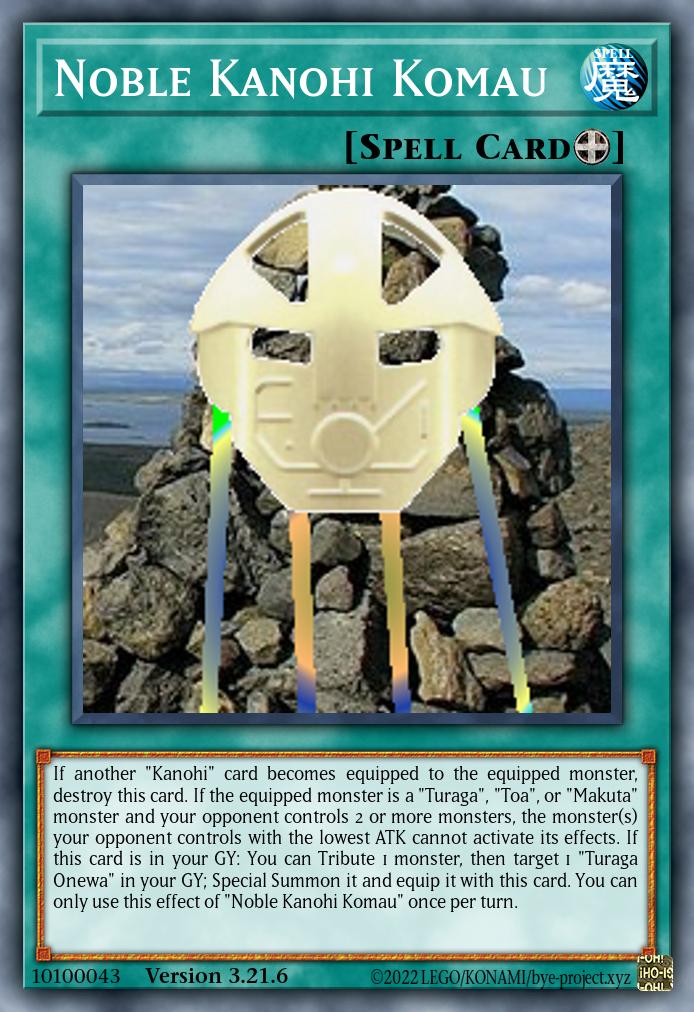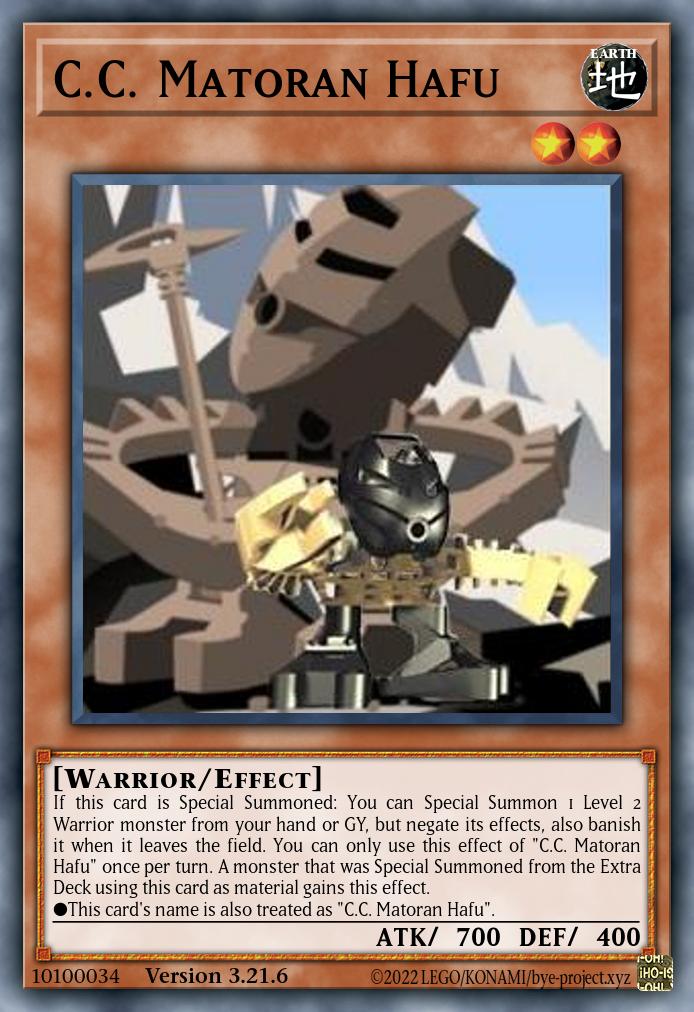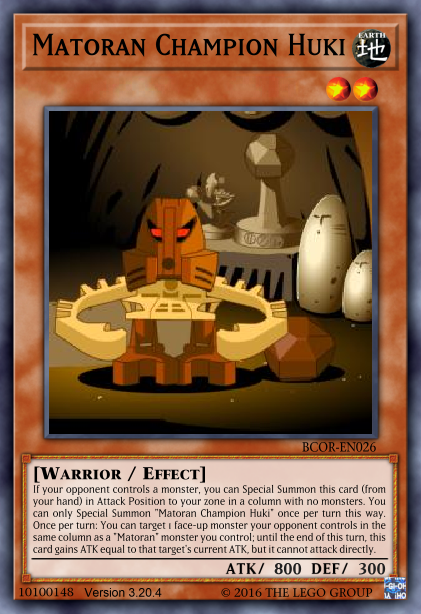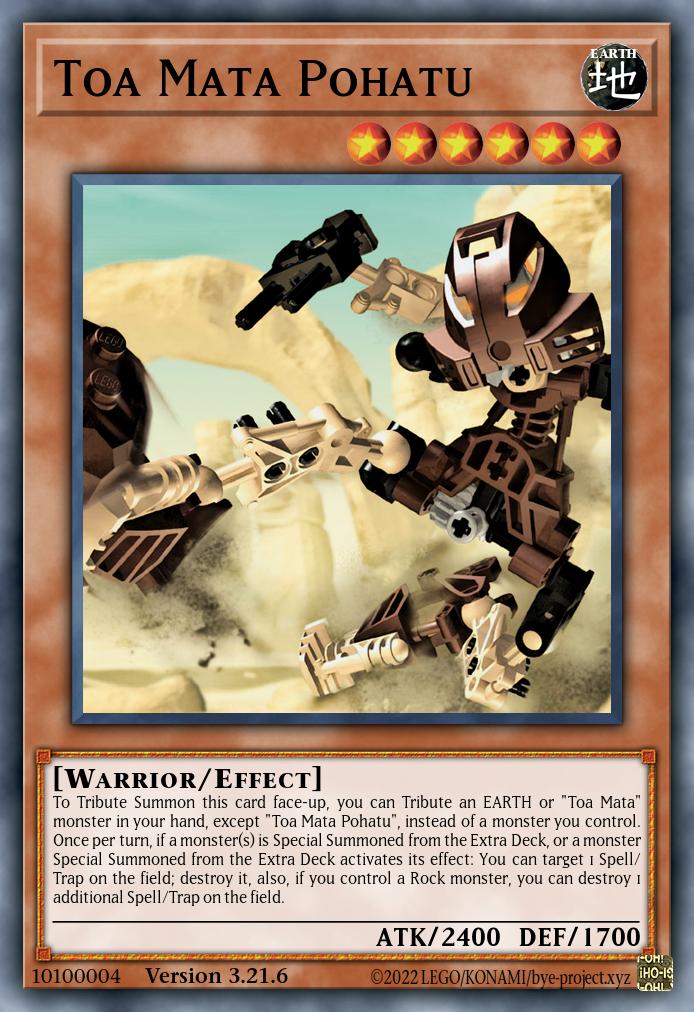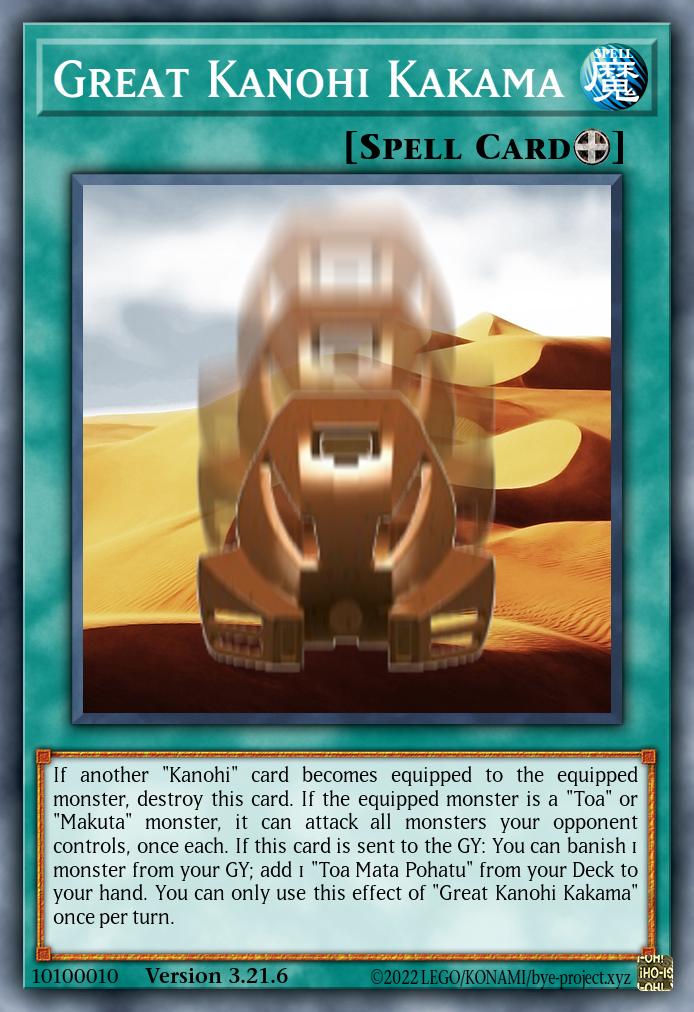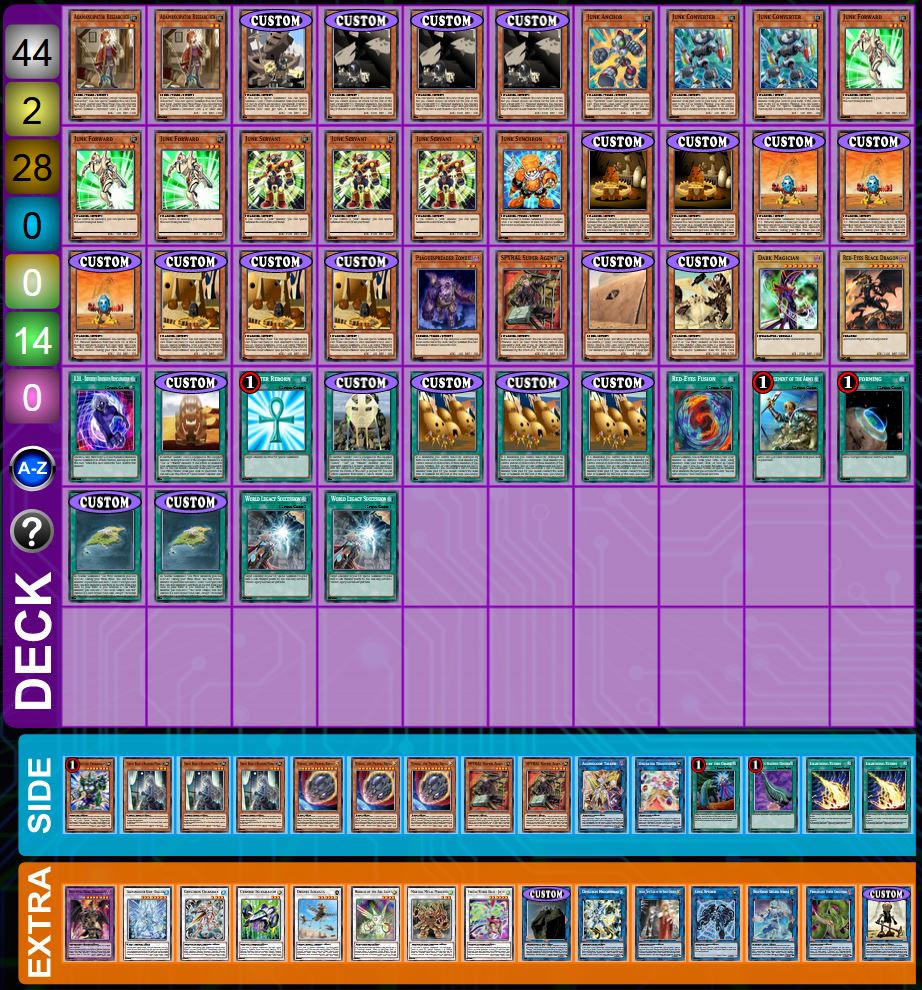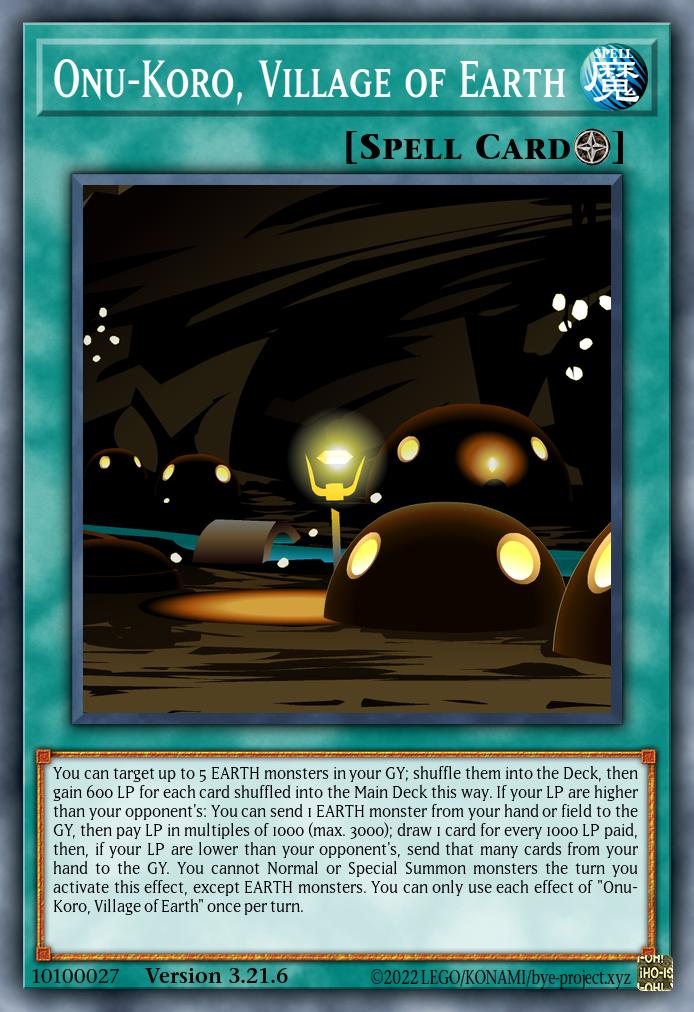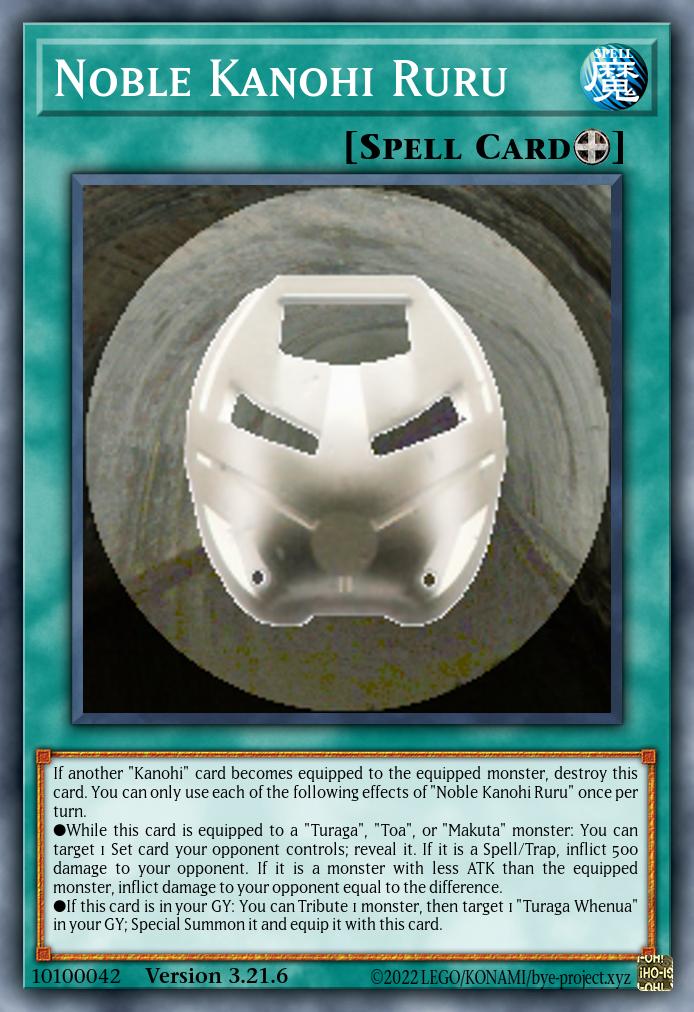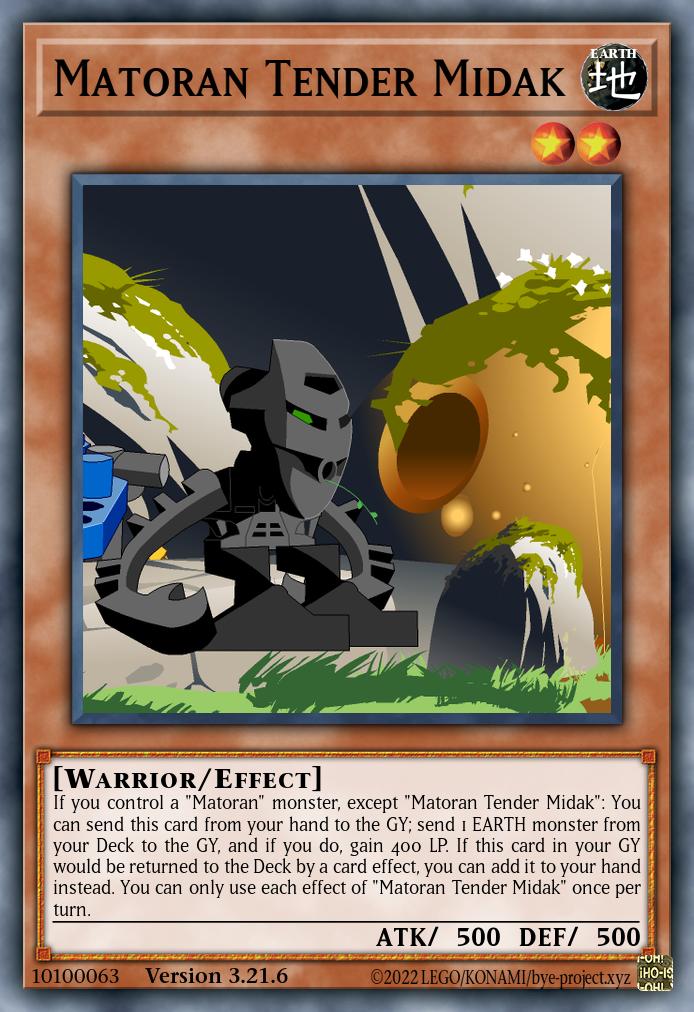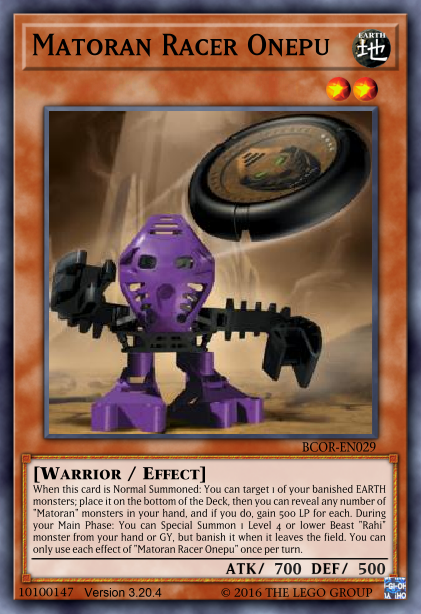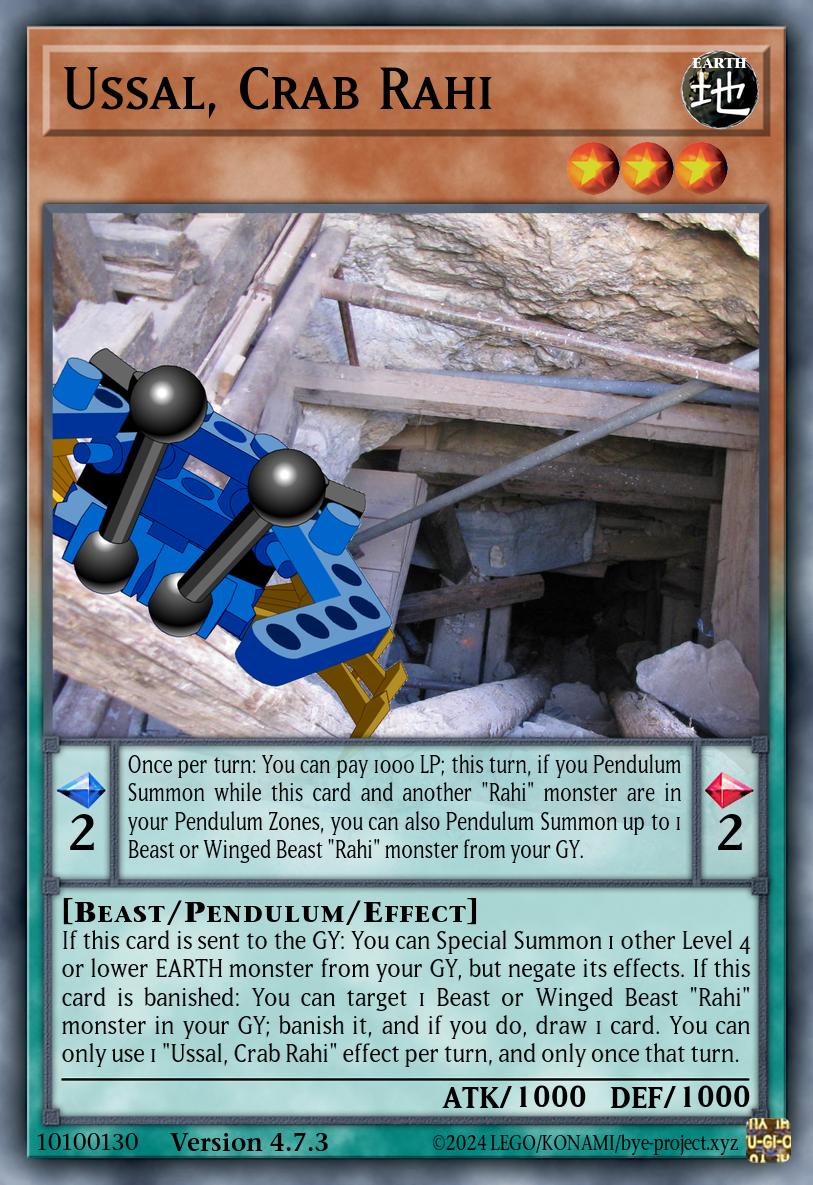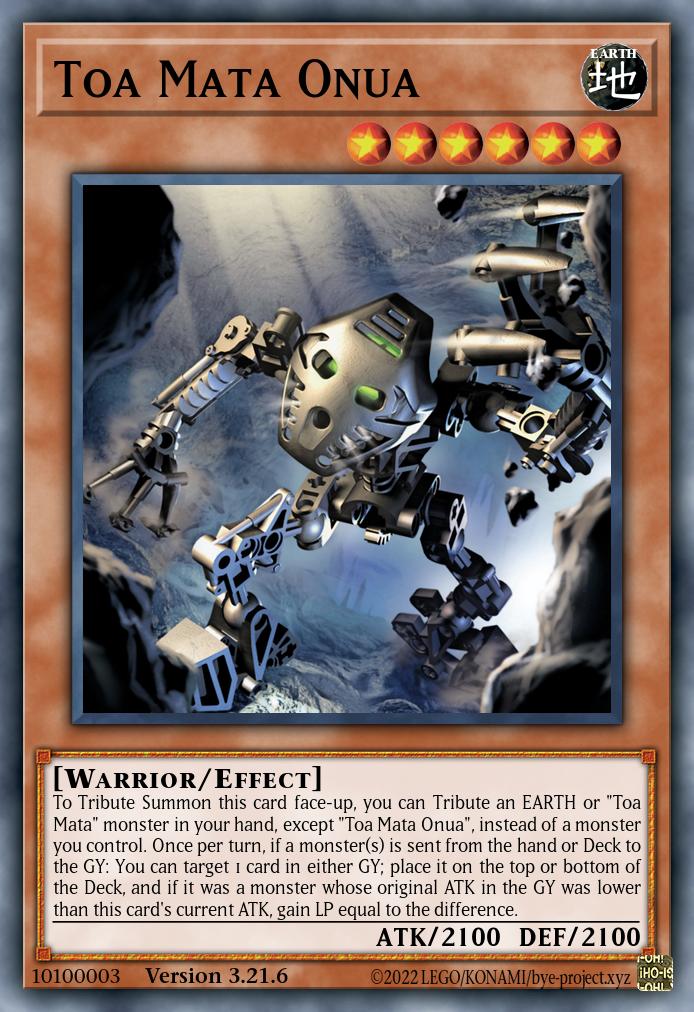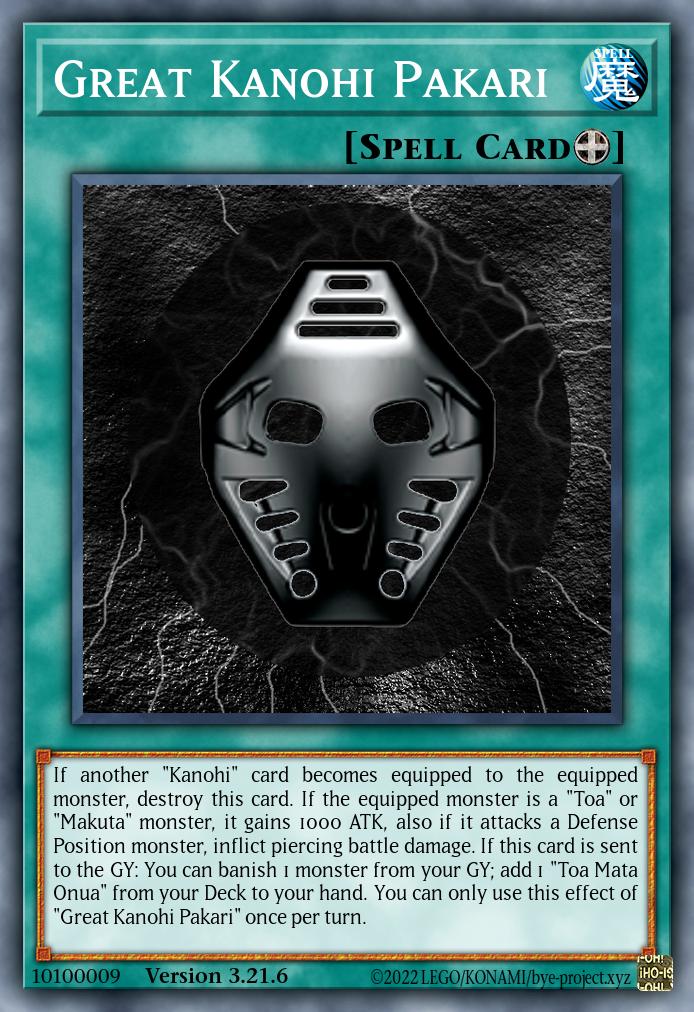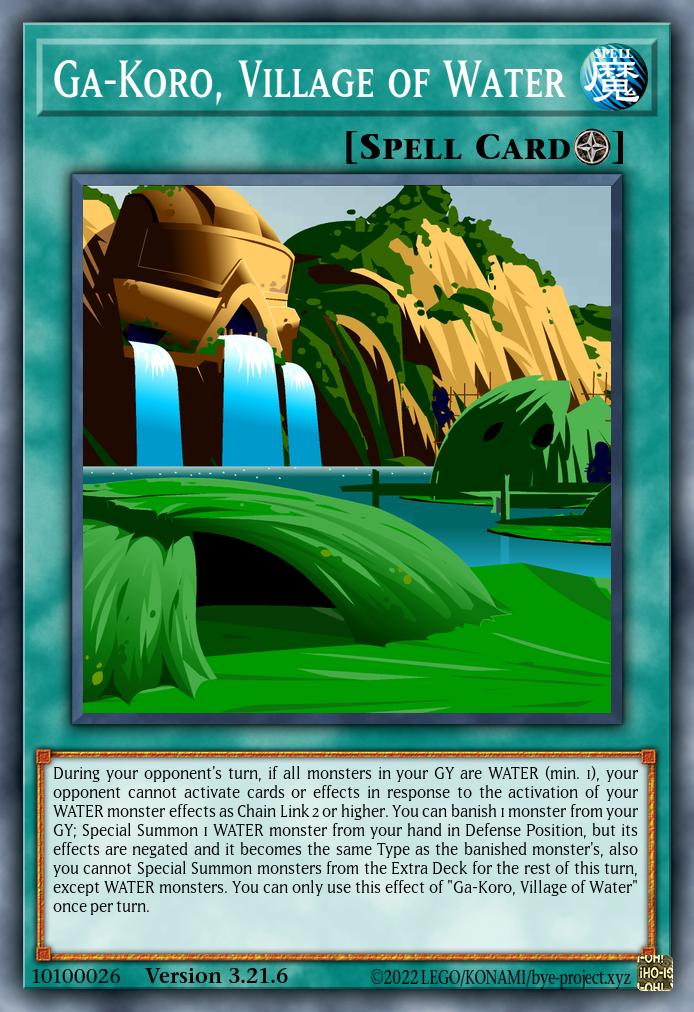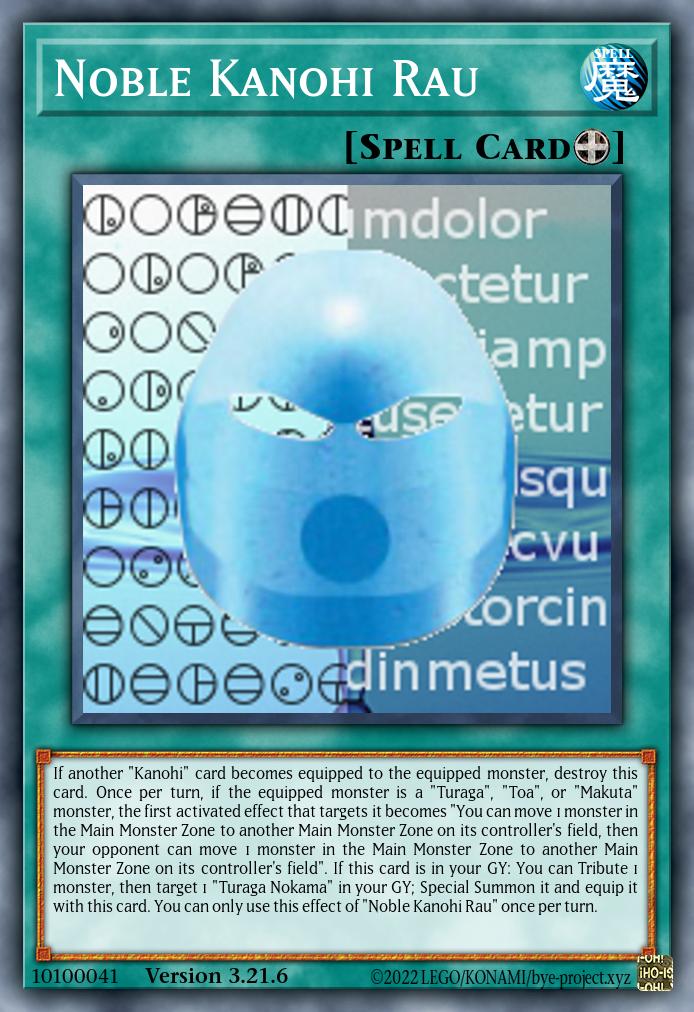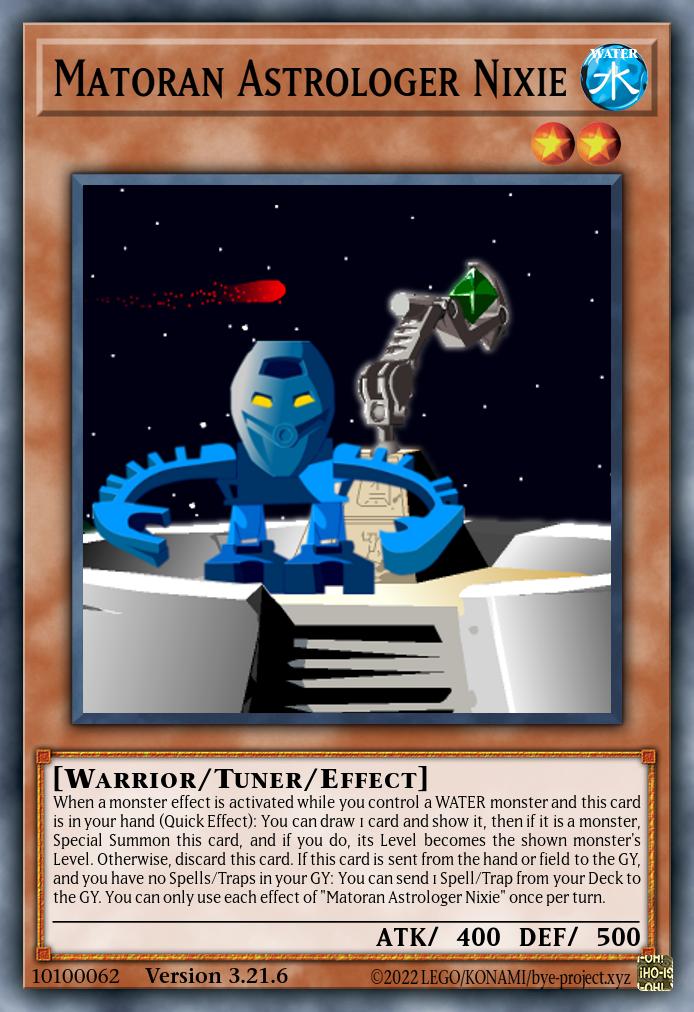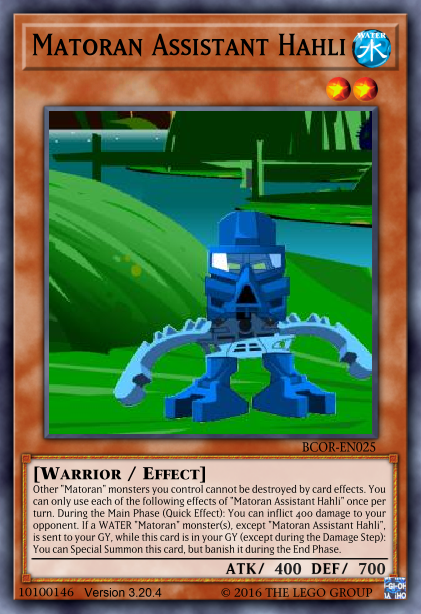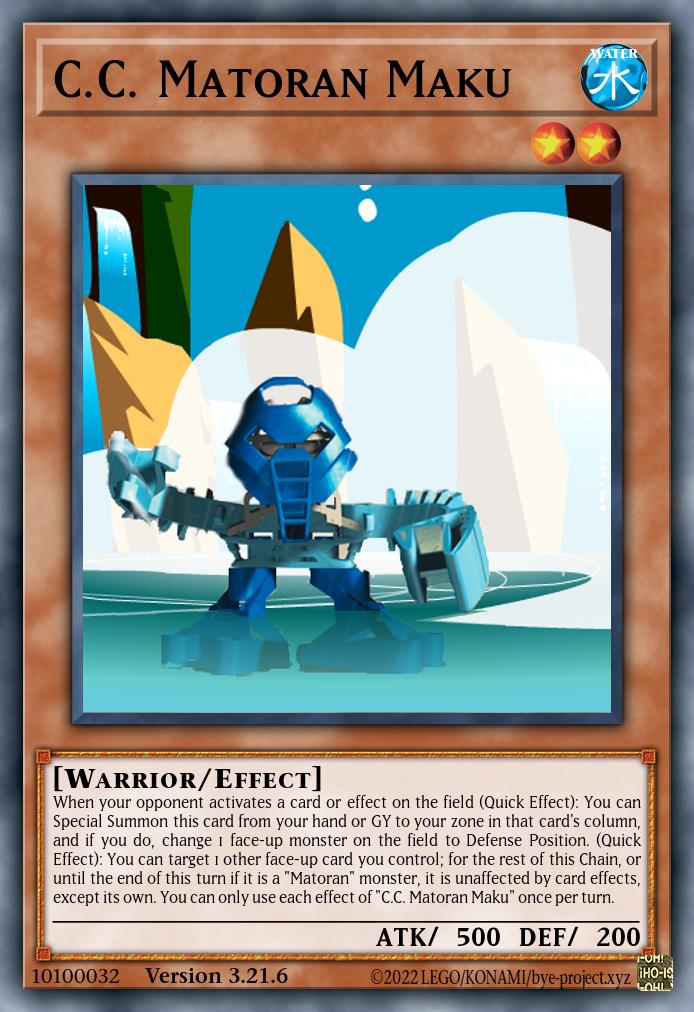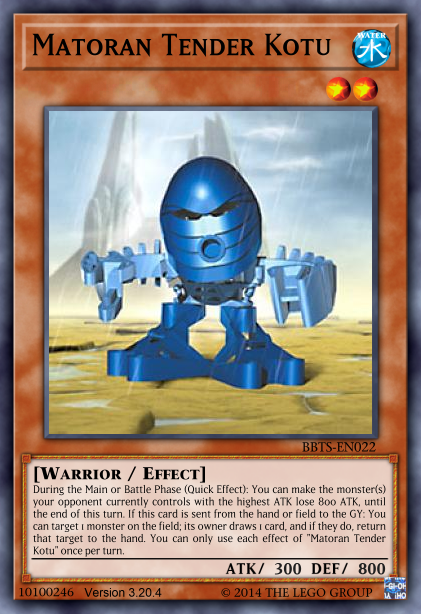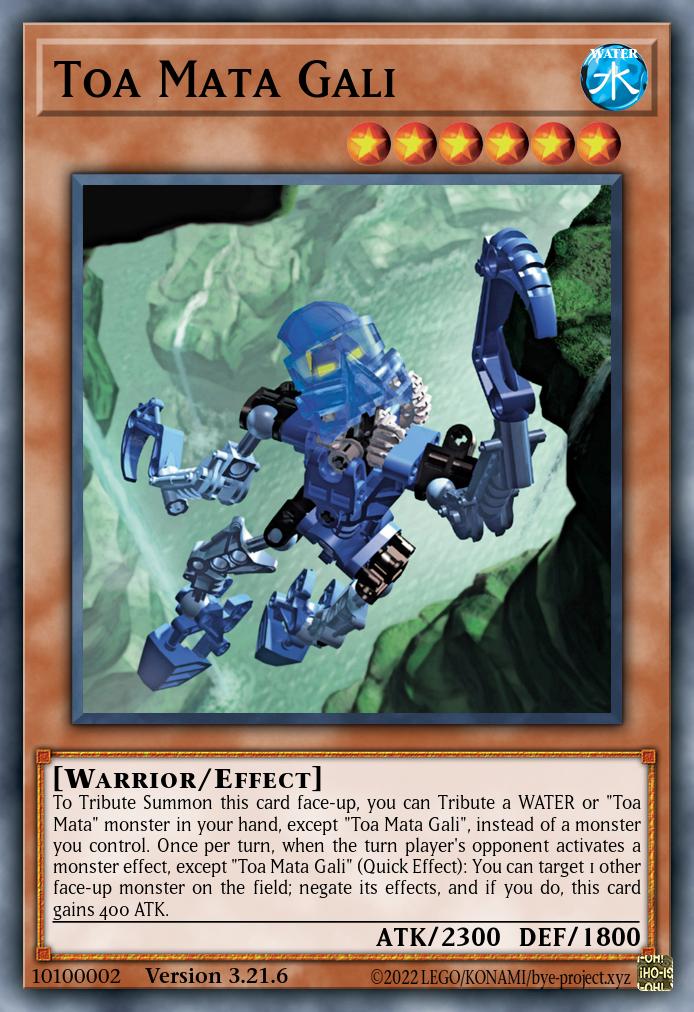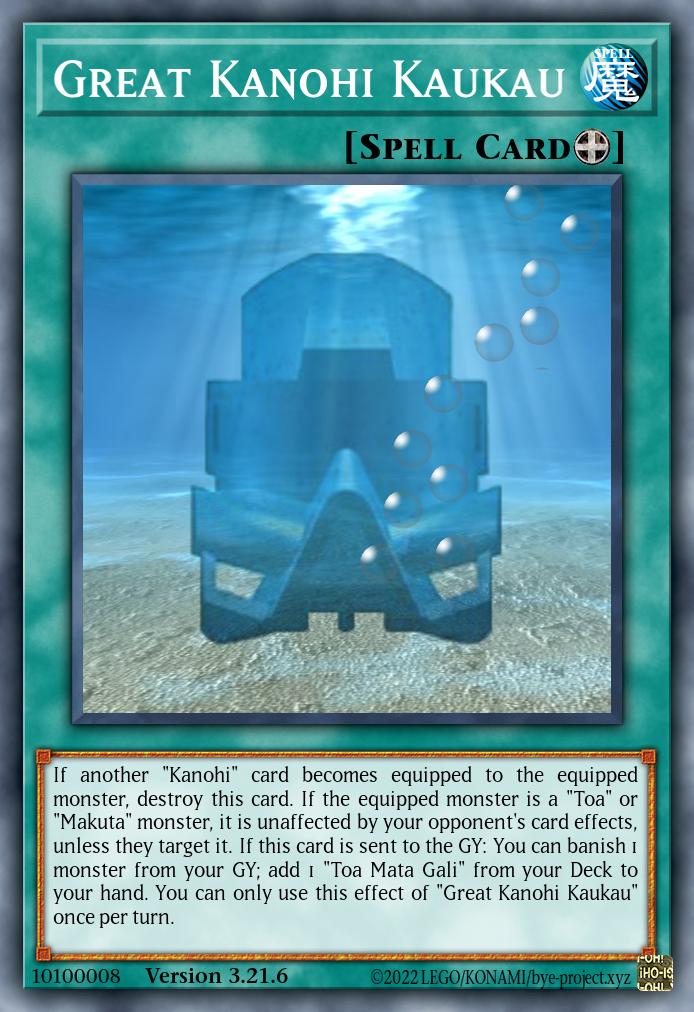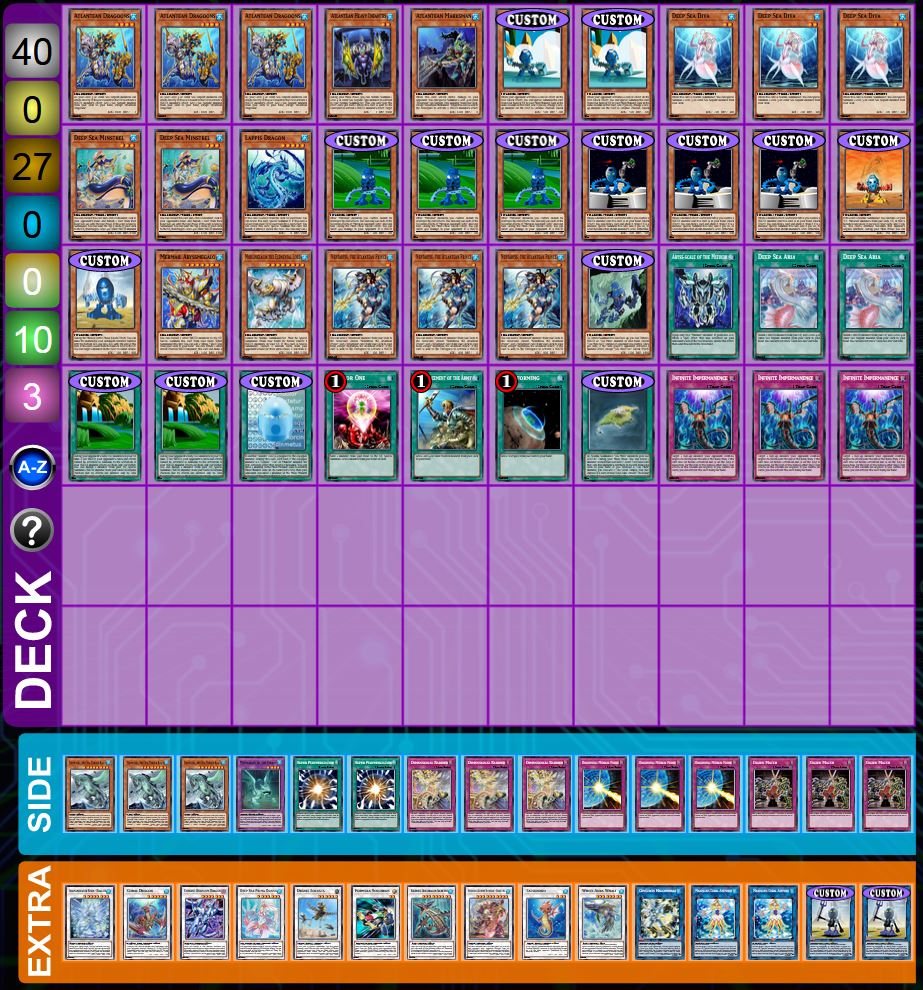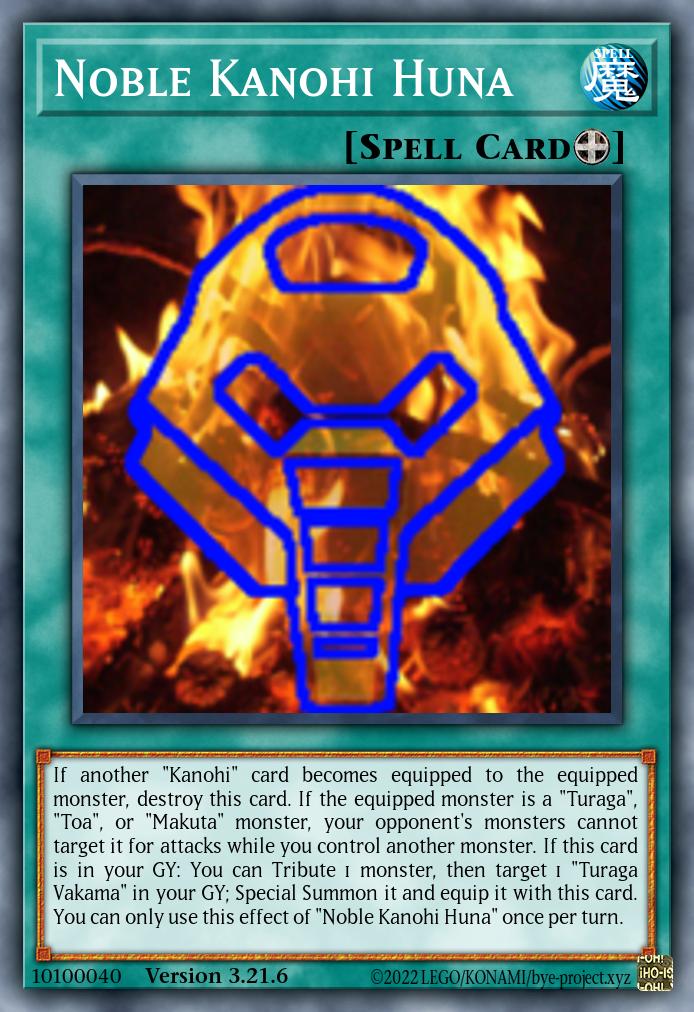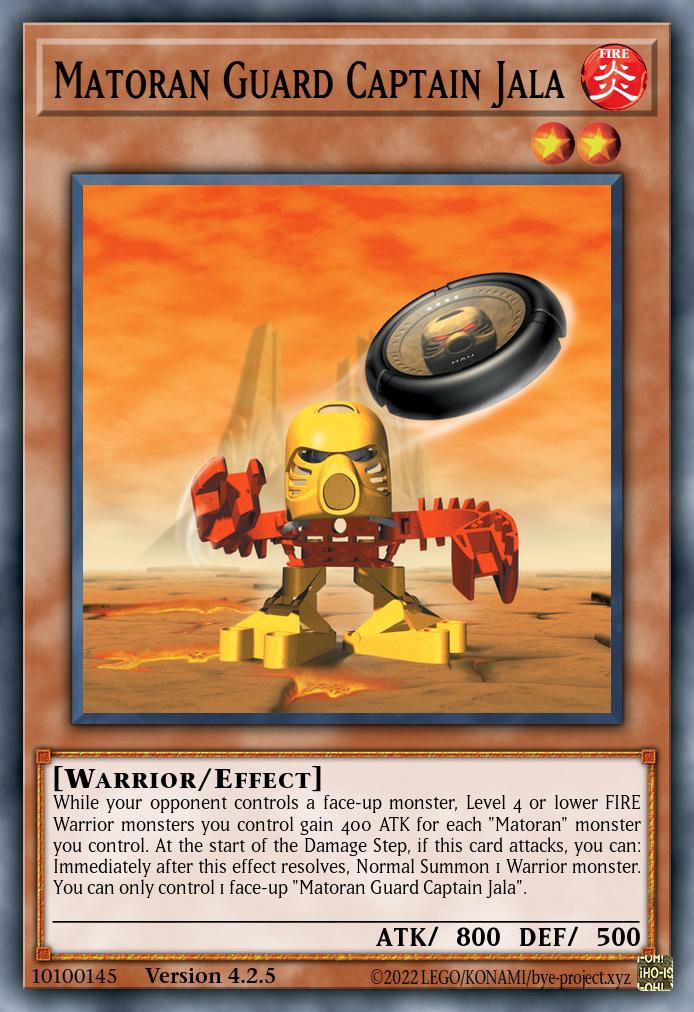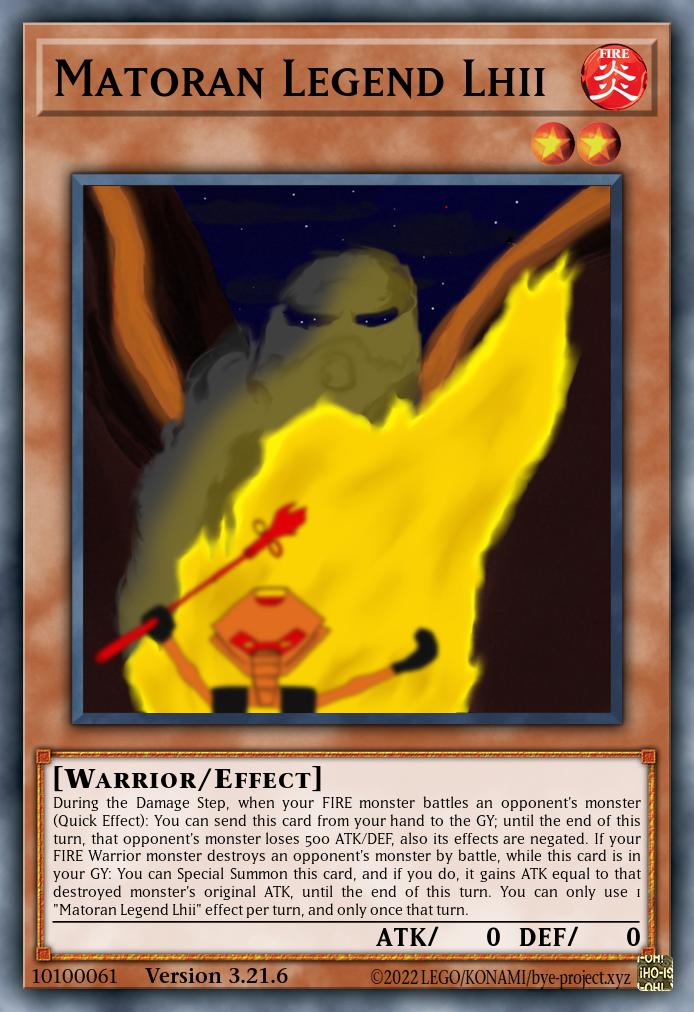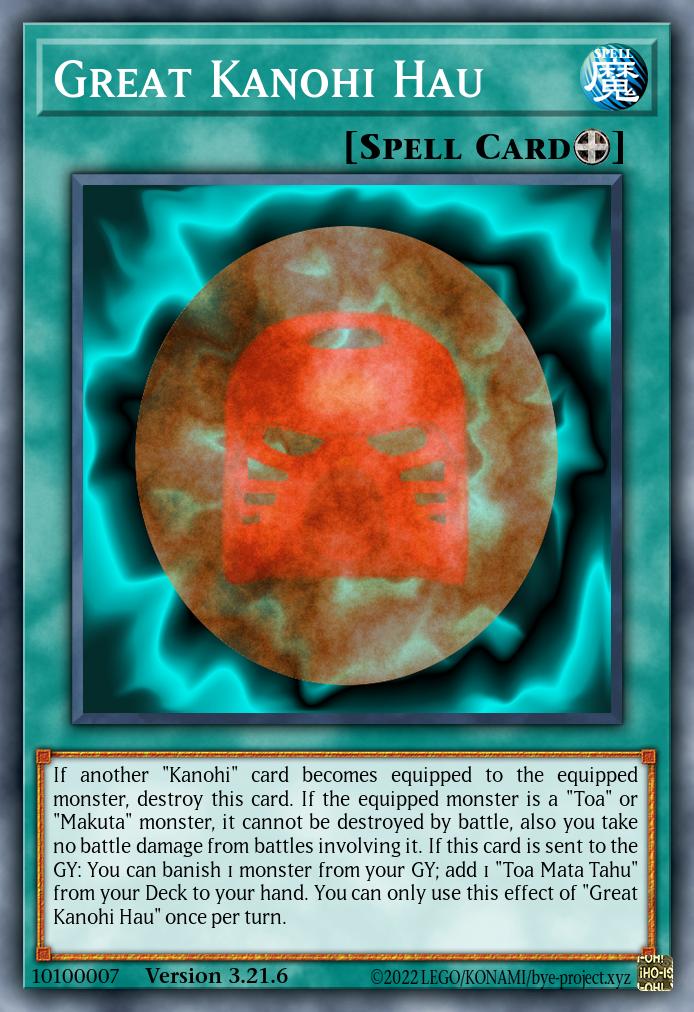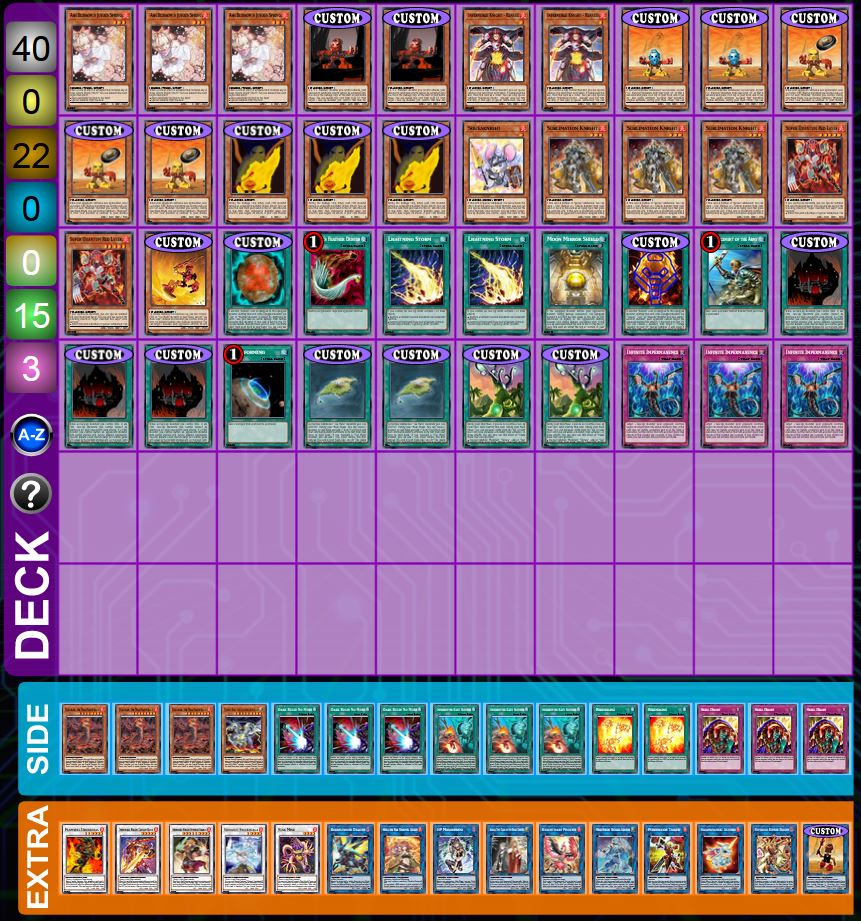The time has come once more: New expansion, new archetypes, and a new chapter of lore to adapt. Grab your popcorn buckets, because we’re going to the movies with Mask of Light! And Mata Nui Online Game II, that’s here too.
Install via EDOPro Configuration
While Protodermic Evolution consisted mostly of upgrades for Toa and Bohrok, this set builds up some new strategies from the ground up, but will also add a fresh coat of polish to the six -Koro strategies that have been neglected for these last few years. Here’s the details.
New Archetypes/Cards
Avohkii
The Avohkii archetype is the one that tells the story of the movie from the perspective of its protagonists: The two humble Matoran who discover the Mask of Light and embark on a quest to find the seventh Toa destined to wield it. Its basic idea is a simple, consistent setup engine that gets you the Main Characters on the field and the Kanohi Avohkii itself to the hand, as well as access to a variety of searchable cards representing events, characters, and concepts from the movie.

Matoran Jaller, Avohkii Herald
Effect MonsterLevel 4 | FIRE Warrior | ATK 1800 / DEF 1200You can reveal 1 “Great Kanohi Avohkii” in your hand; Special Summon this card from your hand. If this card is Normal or Special Summoned: You can add 1 card that mentions “Great Kanohi Avohkii” from your Deck to your hand, except “Matoran Jaller, Avohkii Herald” or an Equip Spell. You can only use each effect of “Matoran Jaller, Avohkii Herald” once per turn.
The first of these we look at in detail is Jaller, leader of the party and the Avohkii’s chosen herald – or so it seems. Befitting his role, he gets to enter the field for free if you have the shiny mask to show off in your hand, and searches most of the cards related to it on summon. The notable omission from this are Equip Spells, because as we know, it is not Jaller’s role to find the mask itself.

Matoran Takua, Avohkii Chronicler
Effect MonsterLevel 4 | LIGHT Warrior | ATK 1500 / DEF 1500You can reveal 1 other card in your hand; Special Summon this card from your hand, then send the revealed card to the GY unless you control 2 or more cards that mention “Great Kanohi Avohkii”. During your Main Phase: You can equip 1 “Avohkii” Equip Spell from your hand, Deck, or GY to 1 “Avohkii” monster you control. You can only use each effect of “Matoran Takua, Avohkii Chronicler” once per turn.
That honor goes to Takua, tagging along to chronicle the historic events unfolding as a result of his serendipitous discovery (even if he’d rather have nothing to do with it). This is the guy who gets you the Equip Spells missing from Jaller’s portfolio, and as a funny little reference to his attempt to dodge responsibility, he can even equip them to another “Avohkii” monster you control – convenient side effect is not always losing to Ghost Ogre. He also has a way to be Special Summoned from the hand by revealing a card, but since his time to shine is precisely when you don’t have the Avohkii yet, any card whatsoever will do; in exchange, you’ll be losing that card if you do this without having prior Avohkii setup.
Basically, what this somewhat convoluted sequence tries to achieve is letting Takua work both as a search off a Normal Summoned Jaller, in which case you’ll get to bring him out at no cost, or as a separate starter who does not take up the Normal Summon, but will make you lose an additional card from the hand. More importantly, going through this effect step by step matches up with the way he talks while hopping across lava in the movie, which I found very funny and was perhaps 70% of the reason I ended up going this way. Mechanically speaking, it really might be better to make the Special Summon only if you control an “Avohkii” card and require the Normal Summon otherwise, so it might still change to that once I get tired of the joke in a later version.
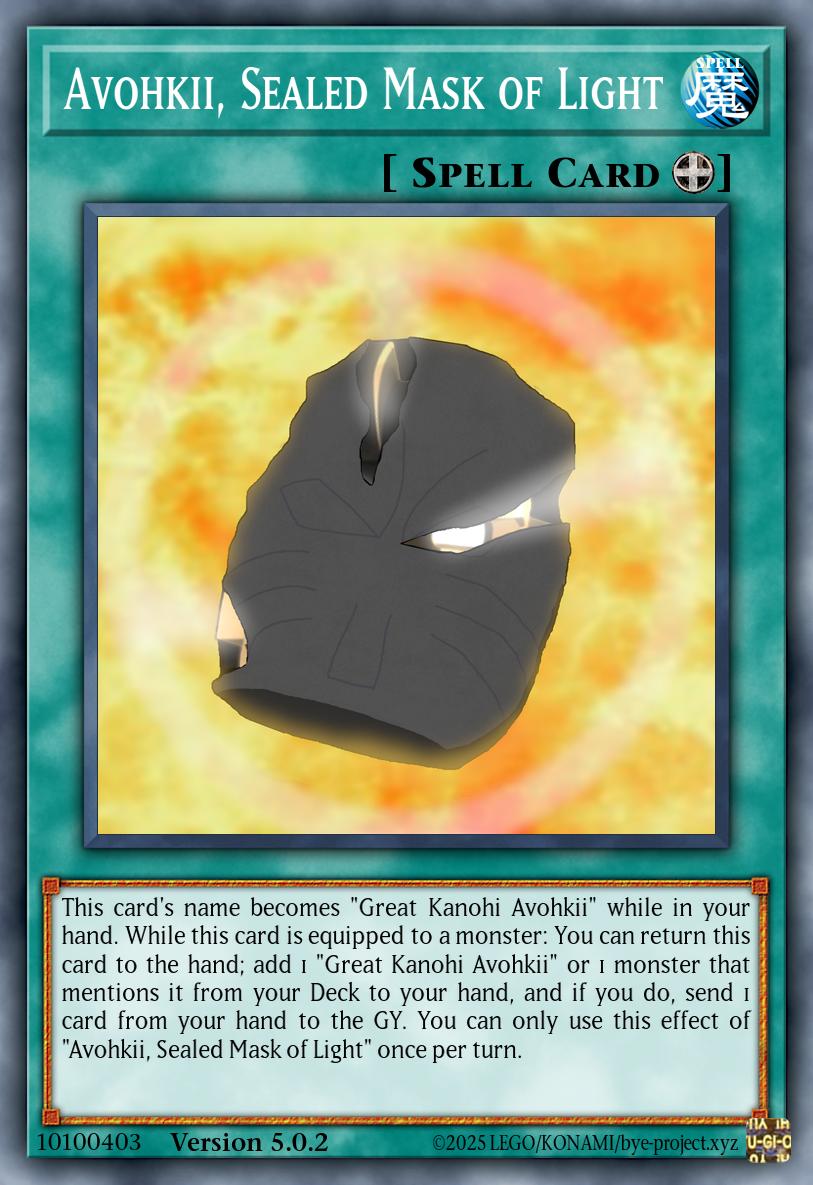
Avohkii, Sealed Mask of Light
Equip SpellThis card’s name becomes “Great Kanohi Avohkii” while in your hand. While this card is equipped to a monster: You can return this card to the hand; add 1 “Great Kanohi Avohkii” or 1 monster that mentions it from your Deck to your hand, and if you do, send 1 card from your hand to the GY. You can only use this effect of “Avohkii, Sealed Mask of Light” once per turn.
Finally, all this talk about using Takua as a starter only makes sense with the context of the one and only Equip Spell he can get at this point in time: Avohkii, Sealed Mask of Light. Or Sealed Avohkii for short.
Revealing the Avohkii in hand is meant to become a recurring element in this theme, so this one takes on that specific name while it is in your hand. That means double the cards you can draw to unlock all those benefits, and at the current preliminary stage it is in fact the only thing you can reveal to satisfy the Special Summon requirement on Jaller. Truly unsealing the Avohkii will take some more time, despite it already being referenced all over the place.
This card is also crucial to the engine’s functioning because, after equipping it, you can return it to your hand to search any Avohkii-related monster, though you’ll have to give up a card in exchange so the advantage math works out right. That bridges Takua to Jaller, or lets you get to either of them if any equip target is present on the field. The fact that it bounces for cost is especially powerful, as that immediately gives you a Kanohi Avohkii to reveal and sets up follow-up for the next turn in the form of another search. It is, however, vulnerable for the small window between equipping it and activating the effect, where a savvy opponent may just chain MST and take that valuable resource away.
The slightly odd search pool of specifically the actual, currently non-existent Avohkii and the monsters (but only the monsters) that mention it came about through the following reasoning: Obviously you need the monsters so the combos work, as explained above. But if you could also search Spells and Traps, you could just play a package of Sealed Avohkii and some convenient backrow cards, many of which are planned to use the hand reveal gimmick and therefore may very well be able to wield their full power in such a scenario. That didn’t seem proper, so those searches have been locked behind Jaller instead, forcing you to play a fuller Avohkii party if you want access to their cards. Finally, searching the real Avohkii itself represents the “unsealing” (for maximum lore accuracy, you should send the Sealed Avohkii to the GY when resolving this effect) – originally it was planned to have this search happen when the Sealed Avohkii is destroyed, but having an effect that only searches a currently non-existent card seemed a bit too weird after all. We’ll see where we end up with that in the long run.
Thusly equipped with three combo pieces that can all get us to the desired setup, we build a first simple deck to make use of it. And where does this repeatable engine that puts two monsters on the field lead us? Into a LIGHT Fiend for Fiendsmith combos, of course.
Other points of note are Rank 4 access through the main combo, the possibility of Chaos Angel with Takua + Engraver, and two neat little packages that further enhance consistency by getting Takua directly from the Deck. One consists of Gen, Ken, and Triple Tactics Thrust to search Naming Day and upgrade the Level 3 LIGHT Warrior you Summoned into the Level 4 LIGHT Warrior you need. The other is Taipu and Prima Light (a card so fresh off the presses I had to use a custom on DB), letting you trade a free EARTH Warrior for a LIGHT Warrior. In a grind game, Gearbreed also shows its worth as a fun tech card, since it lets you recycle Jaller to get value off the Sealed Avohkii in your hand truly forever.
Here’s where I would normally put a sample video, but in this case it’s more a showcase of how the basic combo aligns with what we see in the movie. Worth a watch anyway (he said, unbiasedly).
As you probably noticed above, this is also the first time in this project I’m using alternative artworks – one version coming from the usual set/comic/game sources, and another directly using movie screencaps. Not everyone is a fan of the highly stylized character designs Miramax used (personally I think they’re okay, but easily at their worst in this first movie), so now you get to play whichever you prefer. However, the stone seal on the Avohkii was only ever depicted in movie form, so for that one I had to put my rather limited art skills to work for the first time since Lhii .
Currently the Card Viewer just shows these alt arts as separate cards, as they are in the database. If life stops being so damn busy at some point, I’ll hopefully get a nicer way to include them done.
Future updates for the Avohkii theme will add a variety of searchable Spells and Traps based on scenes from the movie, and a small set of Extra Deck monsters across different summoning types that help you build up advantage while always cycling back into Jaller and Takua. Over the course of a duel, you should (at least theoretically) be able to recreate their journey step by step, from discovering the Mask of Light all the way to finding the seventh Toa.
Kraata
Far away from the light, strange beings crawl through the shadows. They are the Makuta’s own substance, the source of the infected masks that have placed the island’s Rahi under his control, and wielders of many dreadful powers. Introducing the second theme of the set: The Kraata, tiny 0/0 DARK Fiend critters that swarm the field and spread devastation to your opponent’s monsters through the physical contact of battle.
… Yes, I am aware about half of that description overlaps with Yubel, but I swear this concept was in my drafts long before that deck got the modern support wave that made it functional. And taking a closer look at the cards will reveal some major points of distinction in the specifics.
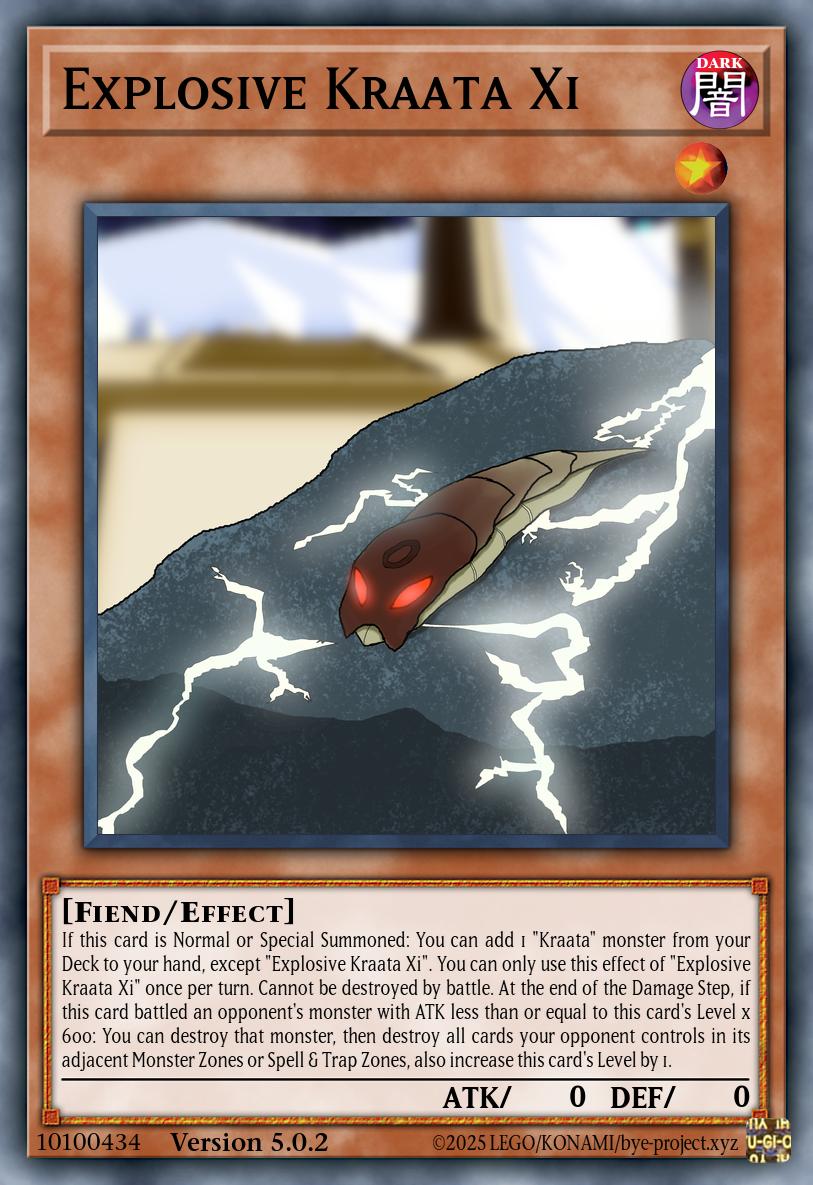
Explosive Kraata Xi
Effect MonsterLevel 1 | DARK Fiend | ATK 0 / DEF 0If this card is Normal or Special Summoned: You can add 1 “Kraata” monster from your Deck to your hand, except “Explosive Kraata Xi”. You can only use this effect of “Explosive Kraata Xi” once per turn. Cannot be destroyed by battle. At the end of the Damage Step, if this card battled an opponent’s monster with ATK less than or equal to this card’s Level x 600: You can destroy that monster, then destroy all cards your opponent controls in its adjacent Monster Zones or Spell & Trap Zones, also increase this card’s Level by 1.
The best point to start is probably the Kraata Xi, the one that simply searches another monster from its archetype when summoned. That’s already the first obvious difference from Yubel, the fact that these aren’t high-Level bosses, but small combo pieces that try to gather in great numbers. Accordingly, their battle protection does not go as far as keeping battle damage away from your LP, and the offensive effects that represent their unique powers only work on enemies up to a certain ATK stat, determined by the Kraata’s own current Level (or “stage”, as it would correctly be called in lore terms). That means they’re more a bonus rather than your primary win condition, usually.
The Xi’s power is Fragmentation – making stuff explode. When it successfully does so to a monster, the splash damage also catches the surrounding cards, so you can do some real field clearing with this if you’re up against careless use of zones. A successful use of its power raises a Kraata Xi’s Level by 1, and thus the ATK threshold for its next target by 600.
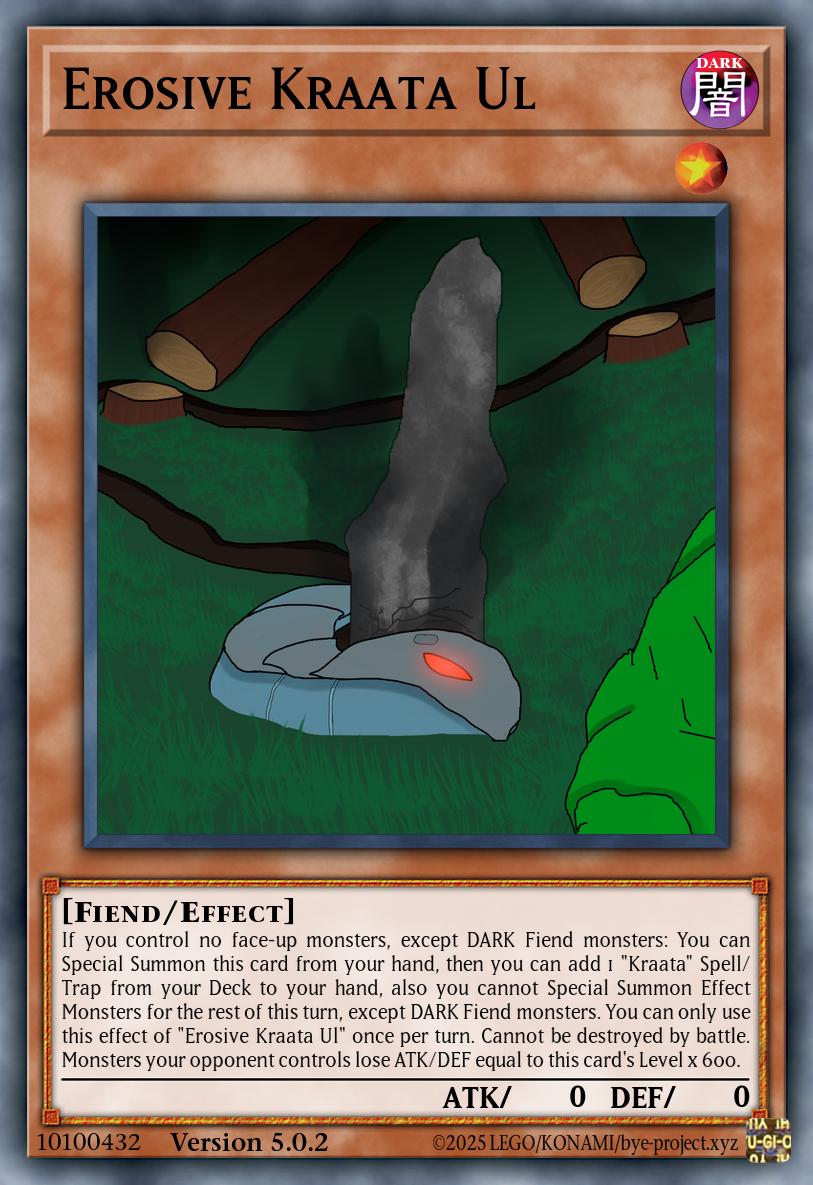
Erosive Kraata Ul
Effect MonsterLevel 1 | DARK Fiend | ATK 0 / DEF 0If you control no face-up monsters, except DARK Fiend monsters: You can Special Summon this card from your hand, then you can add 1 “Kraata” Spell/Trap from your Deck to your hand, also you cannot Special Summon Effect Monsters for the rest of this turn, except DARK Fiend monsters. You can only use this effect of “Erosive Kraata Ul” once per turn. Cannot be destroyed by battle. Monsters your opponent controls lose ATK/DEF equal to this card’s Level x 600.
To make those thresholds a bit more attainable, you may want to pair your attacker with the support of a Kraata Ul, using its Disintegration ability to passively wear away at the stats of your opponent’s monsters. Here we actually see an anti-synergy with Yubel, which wants the opponent’s monsters as big as possible for the purpose of damage reflection.
This one also contributes to the swarming aspect by being able to Special Summon itself as long as your field is exclusively DARK Fiends (or empty), and on top of that it acts as a Spell/Trap searcher when you do that. Since this is rather powerful, it comes with a lock into the aforementioned Type/Attribute combination, though curiously only for Effect Monsters. I will not elaborate on this beyond pointing out that Energized Protodermis Destiny needs to make a LIGHT Aqua Token so it can Fusion Summon.
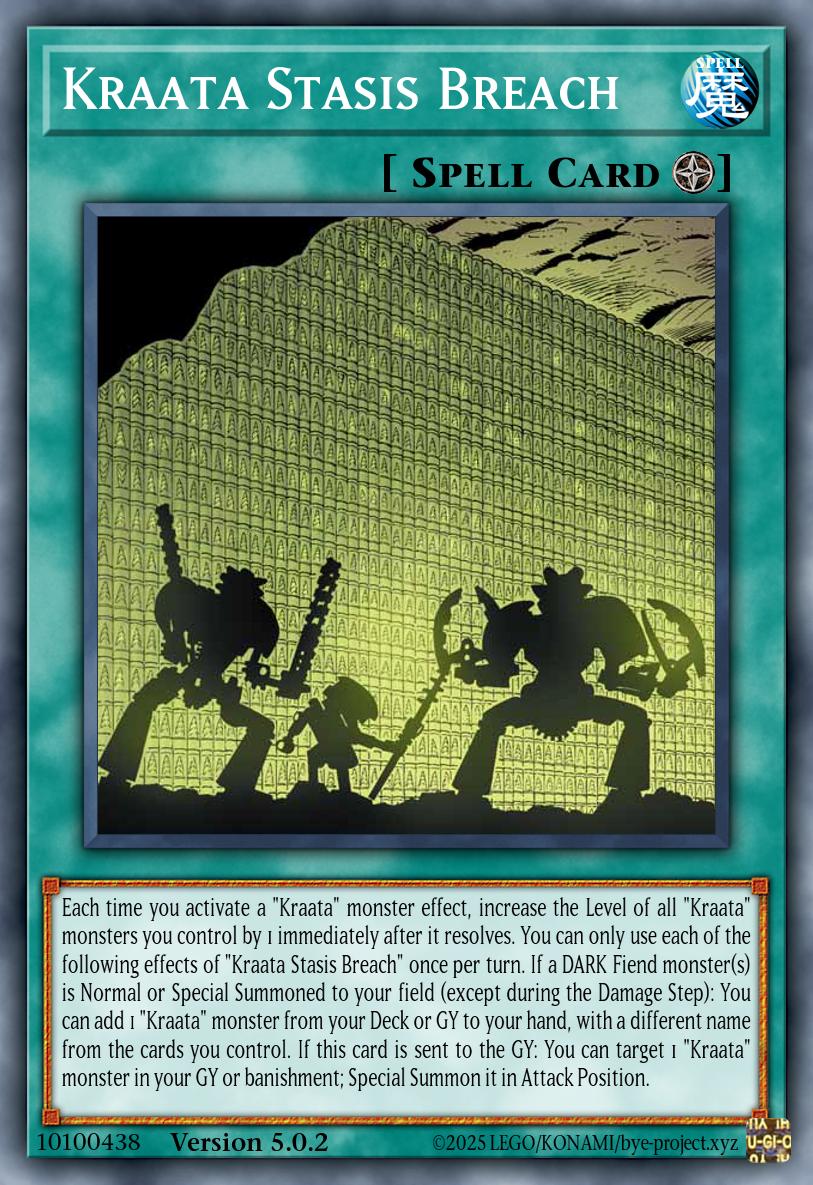
Kraata Stasis Breach
Field SpellEach time you activate a “Kraata” monster effect, increase the Level of all “Kraata” monsters you control by 1 immediately after it resolves. You can only use each of the following effects of “Kraata Stasis Breach” once per turn. If a DARK Fiend monster(s) is Normal or Special Summoned to your field (except during the Damage Step): You can add 1 “Kraata” monster from your Deck or GY to your hand, with a different name from the cards you control. If this card is sent to the GY: You can target 1 “Kraata” monster in your GY or banishment; Special Summon it in Attack Position.
The previous card kind of left two questions hanging, namely “what Kraata Spells/Traps” and “how does this gain Levels”. Both are answered by the Field Spell, which is a Spell (duh) and advances all your Kraata by 1 each time one of their effects resolves. That means putting a few of them on the field while this is up can actually get you to a point where the battle effects are a reasonable threat to an established board.
Like any Field Spell you want to be run at 3 copies should do, it also enhances consistency, in this case by translating any DARK Fiend you Summon into a Kraata in your hand. In testing, this turned out to give pretty insane value over time because a lot of DARK Fiend stuff can also Summon on the opponent’s turn, and in light of future plans I’m almost considering making it add only from the Deck and also requiring a name different from the ones in your GY. But with only 2 Kraata in existence right now, I didn’t want to impose that restriction just yet.
And finally, as a Makuta-related Spell/Trap, it does something in the GY, namely reborn a Kraata when sent there. This is kind of a flavor effect to represent the actual “Breach” that happens in the Kraata Cave moments after the card image. Hence why it summons in Attack Position, that Kraata is ready to strike.
By the way, in case the monsters had you wondering if there were really images so directly focusing on the Kraata using their powers, there actually weren’t. In fact, there was basically no usable promotional art of any specific Kraata type, forcing me to break out the literal drawing board for the second and third time in this single release. The shit I put up with, seriously.
Looking forward to doing this at least four more times for this archetype, oh joy. Hell, might as well go for the other 36 Kraata types that totally needed to exist while I’m already at it.
In spite of all the differences explained above, you do actually play these with Yubel and the related usual suspects for now. It’s just the most effective combo shell that falls in line with the DARK Fiend lock, other than sometimes not being able to use the red dog. The recent TCG exclusive Fiend Fusion support is also pretty good here, letting you bridge from the more generic combos into Kraata via Aerial Eater.
In fact, the plan for future versions, other than adding the remaining Kraata, calls for Rahkshi in the form of Fusion Monsters, so that’s a very promising direction. Those will also act as proper boss monsters that can deal with stuff too high on the ATK ladder for squishy little Kraata, so I expect the awkward inclusion of Yubel specifically may go away as we approach completion.
See below for some test footage with this deck.
The Final Chronicle
Finally (haha), this set includes a second Matoran-based engine, hailing from Mata Nui Online Game II: The Final Chronicle. Rather than a standalone thing, this is something you can add to any of the established Koro decks, along with other new cards to enhance those strategies.
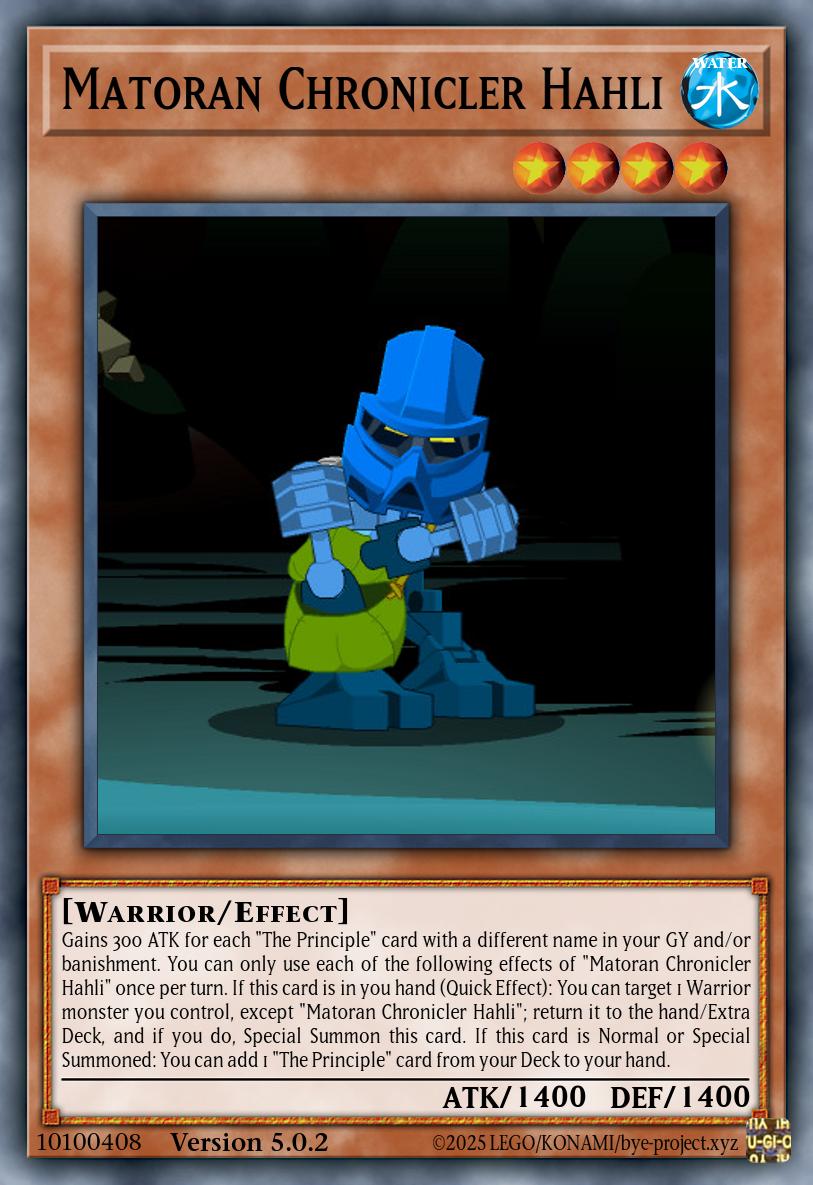
Matoran Chronicler Hahli
Effect MonsterLevel 4 | WATER Warrior | ATK 1400 / DEF 1400Gains 300 ATK for each “The Principle” card with a different name in your GY and/or banishment. You can only use each of the following effects of “Matoran Chronicler Hahli” once per turn. If this card is in you hand (Quick Effect): You can target 1 Warrior monster you control, except “Matoran Chronicler Hahli”; return it to the hand/Extra Deck, and if you do, Special Summon this card. If this card is Normal or Special Summoned: You can add 1 “The Principle” card from your Deck to your hand.
The core of it all is Hahli, a Ga-Matoran surprisingly chosen to represent her village in the Kolhii championship. This task has her journeying across Mata Nui, learning the Principles of each village that form the foundation of their Kolhii Skills. Therefore: She searches those Principles and grows stronger the more of them you apply. For smooth integration in the different decks, all it takes to summon her is bouncing a Warrior you control, which doubles as a way to dodge stuff and triples as a reference to her spontaneously replacing Kotu on the team. Poor Kotu, they don’t let her have shit.

The Principle Of Purity
Quick-Play SpellTarget 1 “Matoran”, “Toa”, or “Turaga” monster you control and 1 face-up card your opponent controls; negate their effects until the end of this turn, then, if all monsters in your GY are the same Attribute (min. 1), you can destroy that opponent’s card. At the end of the Damage Step, if your Warrior monster attacked: You can banish this card from your GY; it can make a second attack in a row. You can only use each effect of “The Principle of Purity” once per turn.
And now for the Principles, starting from the first one you encounter in the game: Purity. As I certainly mentioned in some article way back when, the effects of the six Koro Field Spells were actually modeled on these in, uh, principle, so the basic idea for their direct representation in cards is to have them kind of loosely be one-shot versions of whatever the Field Spells do. In the case of Ga-Koro , its focus is protecting your plays from interference as long as you keep your GY “pure”, so the associated Principle of Purity similarly offers negation to protect your plays and adds removal if you happen to have a pure GY.
Other than the fundamental mechanical differences between a static Field Spell and a dynamic Quick-Play Spell, the Principle version adds a requirement of having a Matoran/Toa/Turaga to negate along with the target card, and indeed all of them will be restricted to working with those archetypes. You’ll have to play the villagers if you want to make use of their culture. Meanwhile, there isn’t any explicit Attribute synergy here (as that would make it hard to use Hahli with other villages), but Ga-Matoran do still align especially well with this Principle due to the Quick Effects they tend to have being able to slip past the negation before it applies.
A secondary thing each of these six cards will offer is a GY effect that grants some benefit to Warrior monsters. This is the Kolhii skill derived from the Principle, and for Purity that means Speed, simply allowing an extra attack.
For testing, I integrated the new cards into a Ga-Koro deck that aims to set up the dream team of Nokama and Chengying. Icejade Ran Aegirine helps us do the latter somewhat consistently, while the former can generally be cobbled together from Ga-Matoran. Ice Doll is also convenient for several reasons, one being that it’s an extra body, another that it gets you a card in hand for Nokama’s discard, and another that its Mirror is a somewhat useful Spell/Trap that Nixie can send to the GY if you miss with her effect.
Here, big Hahli (not to be confused with small Level 2 Hahli ) serves her intended purpose of just sneaking into a Ga-Matoran setup whenever you happen to draw her, getting you a copy of Purity to further counter anything that may still threaten your board. The End Phase effect of Nokama can also get her back to the hand, so you can actually repeat that move as often as the Principles in your deck allow (so twice in this case – seems to be enough).
And once again, a testing video. I would like to draw your attention to the faithfully recreated MNOG2 loading screens and UI popups, those were pretty fun to do.
That concludes the preview, thanks for coming. The next update will consist of the first dedicated wave of support to the Avohkii deck, hope to see you again then!

